- Home
- About
- Map
- Trips
- Bringing Boat West
- Migration West
- Solo Motorcycle Ride
- Final Family XC Trip
- Colorado Rockies
- Graduates' XC Trip
- Yosemite & Nevada
- Colorado & Utah
- Best of Utah
- Southern Loop
- Pacific Northwest
- Northern Loop
- Los Angeles to NYC
- East Coast Trips
- 1 Week in Quebec
- Southeast Coast
- NH Backpacking
- Martha's Vineyard
- Canadian Maritimes
- Ocracoke Island
- Edisto Island
- First Landing '02
- Hunting Island '02
- Stowe in Winter
- Hunting Island '01
- Lake Placid
- Chesapeake
- Provincetown
- Hunting Island '00
- Acadia in Winter
- Boston Suburbs
- Niagara Falls
- First Landing '99
- Cape Hatteras
- West Coast Trips
- Mojave 4WD Course
- Colorado River Rafting
- Bishop & Death Valley
- Kauai
- Yosemite Fall
- Utah Off-Road
- Lost Coast
- Yosemite Valley
- Arizona and New Mexico
- Pescadero & Capitola
- Bishop & Death Valley
- San Diego, Anza Borrego, Joshua Tree
- Carmel
- Death Valley in Fall
- Yosemite in the Fall
- Pacific Northwest
- Utah Off-Roading
- Southern CA Deserts
- Yosemite & Covid
- Lake Powell Covid
- Eastern Sierra & Covid
- Bishop & Death Valley
- Central & SE Oregon
- Mojave Road
- Eastern Sierra
- Trinity Alps
- Tuolumne Meadows
- Lake Powell Boating
- Eastern Sierra
- Yosemite Winter
- Hawaii
- 4WD Eastern Sierra
- 4WD Death Valley +
- Southern CA Deserts
- Christmas in Tahoe
- Yosemite & Pinnacles
- Totality
- Yosemite & Sierra
- Yosemite Christmas
- Yosemite, San Diego
- Yosemite & North CA
- Seattle to Sierra
- Southwest Deserts
- Yosemite & Sierra
- Pacific Northwest
- Yosemite & South CA
- Pacific Northwest
- Northern California
- Southern Alaska
- Vancouver Island
- International Trips
- Index
- Tips
- Books
- Photos/Videos
- Search
- Contact
Aquinnah
Tuesday, July 8, 2008 - 12:00pm by Lolo miles and hours from our last stop
Travelogue
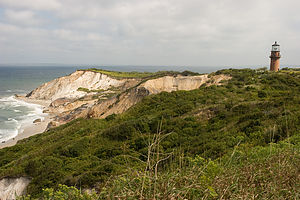 Gay Head Cliffs and Lighthouse from Top of CliffsI still tend to slip and call this Gay Head, because that’s what everyone did until it was changed in 1997 to the more politically correct “Aquinnah,” which is Native American for “land under the hill.” Out of the year round population of 311 people, approximately half are members of the Wampanoag tribe that settled on the island centuries before English settlers arrived and felt the need to convert them to Christianity.
Gay Head Cliffs and Lighthouse from Top of CliffsI still tend to slip and call this Gay Head, because that’s what everyone did until it was changed in 1997 to the more politically correct “Aquinnah,” which is Native American for “land under the hill.” Out of the year round population of 311 people, approximately half are members of the Wampanoag tribe that settled on the island centuries before English settlers arrived and felt the need to convert them to Christianity.
Anyone that has seen postcards or photos of Martha’s Vineyard will recognize the iconic image of Aquinnah’s dramatically colorful clay cliffs, laced with multicolor bands of red, yellow, white, and gray.
One of the best vantage points to view the cliffs is from the Gay Head Lighthouse, which sits atop the cliffs. The lighthouse is open to the public on Friday, Saturday and Sunday evenings from one hour before sunset to a half hour after sunset, from the summer solstice to the fall equinox.
The approach to the lighthouse is a path lined with gift shops selling native Wampanoag wares and several take-out chowder and seafood shacks.
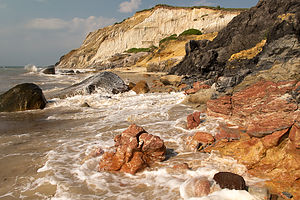 Moshup Beach Cliffs at High TideHowever, the best view in my opinion is from down below on Moshup Beach. Besides one visit here with the kids when they were little, we really didn’t start coming here regularly until just two years ago. When they were along, we tended to spend most of our time on the eastern end of the island in Edgartown and Chappaquiddick. But now that it pretty much is just Herb and I, we like to mix it up and spend time beaching and photographing what the Travel Channel has selected as one of the top 10 beaches in the country. Despite its uniqueness and beauty, its remote location from the more touristy parts of the island makes it much less crowded than the other public beaches on the island.
Moshup Beach Cliffs at High TideHowever, the best view in my opinion is from down below on Moshup Beach. Besides one visit here with the kids when they were little, we really didn’t start coming here regularly until just two years ago. When they were along, we tended to spend most of our time on the eastern end of the island in Edgartown and Chappaquiddick. But now that it pretty much is just Herb and I, we like to mix it up and spend time beaching and photographing what the Travel Channel has selected as one of the top 10 beaches in the country. Despite its uniqueness and beauty, its remote location from the more touristy parts of the island makes it much less crowded than the other public beaches on the island.
The walk along this ½-mile beach at the base of the 130-foot high cliffs is breathtaking, with crashing waves to one side and the stunningly beautiful, multicolored cliffs on the other—not to mention the creative and whimsical rock cairn art to maneuver around along the way.
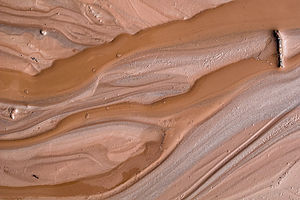 Moshup Beach Red Clay RivuletIn many places, little rivulets of red clay seep out of the cliffs and flow towards the sea. In the 60s and 70s, it was a popular activity for nude sunbathers to partake in “clay baths” and cover their bodies with clay. While playing with the clay is no longer allowed, the nude sunbathing tradition lives on at the far end of the beach.
Moshup Beach Red Clay RivuletIn many places, little rivulets of red clay seep out of the cliffs and flow towards the sea. In the 60s and 70s, it was a popular activity for nude sunbathers to partake in “clay baths” and cover their bodies with clay. While playing with the clay is no longer allowed, the nude sunbathing tradition lives on at the far end of the beach.
For the last two or three summers, Herb and I have driven the RV down to the western end of the island (up-island as locals say) and parked in the big town lot at the end of State Road. It is $15 for the full day. From the parking lot, the Moshup Trail is a 10-minute, very pretty walk to the beach.
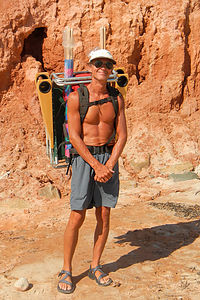 Herb and his "Beach System"Since the walk is pretty far, we tend to bring our stuff for the whole day—beach chairs, books, lunch, cocktails, and much camera gear. Herb has developed a “system” for carrying all this stuff. He starts with one of his old backpacks, straps two wind guards to each side, hangs the beach chairs on the wind guard poles, straps his tripod to the top, and stuffs everything else inside. I follow like a queen.
Herb and his "Beach System"Since the walk is pretty far, we tend to bring our stuff for the whole day—beach chairs, books, lunch, cocktails, and much camera gear. Herb has developed a “system” for carrying all this stuff. He starts with one of his old backpacks, straps two wind guards to each side, hangs the beach chairs on the wind guard poles, straps his tripod to the top, and stuffs everything else inside. I follow like a queen.
We like to spend the entire day here, swimming and reading, and waiting for the low light at the end of the day to paint the cliffs in even brighter hues. That’s when the cameras come out.
Last summer, Andrew and his girlfriend Celeste interned in Boston, so they popped down to the island to join us on the weekends. We had been bringing Andrew to the island once or twice a year since he was 3 months old, so it was nice to show him something new to add to his list of favorite spots on the island.
 Andrew and Celeste at Moshup Beach - LEGAnother favorite spot in Aquinnah that we have been coming to for years is Lobsterville Beach. Its location on the northwest side of the island, on the Vineyard Sound, makes it a perfect place to watch the sun set over the water, which we have done at least once every year since the 80s. The problem, however, is parking, as there are only 8 non-resident spots at the end of West Basin Road. This is particularly challenging with an RV, but we do manage to fit with the back of the RV hanging over the bushes.
Andrew and Celeste at Moshup Beach - LEGAnother favorite spot in Aquinnah that we have been coming to for years is Lobsterville Beach. Its location on the northwest side of the island, on the Vineyard Sound, makes it a perfect place to watch the sun set over the water, which we have done at least once every year since the 80s. The problem, however, is parking, as there are only 8 non-resident spots at the end of West Basin Road. This is particularly challenging with an RV, but we do manage to fit with the back of the RV hanging over the bushes.
During our “foolish youth” phase, we used to come here to BBQ and make a bonfire on the beach. If I remember correctly, there might have been some liquor involved as well. On one of these bonfire nights, we were approached by a town official, who quite nicely suggested that our fire was illegal. After chatting with him awhile, he generously told us to continue with our fun and to tell anyone that bothered us that “Chief Taylor said it was okay.” Only later did we realize that this was James Taylor’s younger brother. James Taylor, as well as his ex-wife Carly Simon, live on the island.
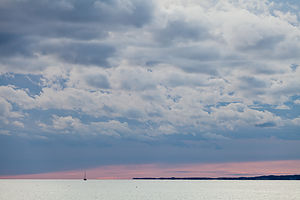 Elizabeth Islands SkyWhile not particularly great for swimming, because of the rocks and seaweed, it is an excellent spot to fish for blues, flounder, and striped bass. You can fish along the 2-mile beach or from the rock jetty that is just across the channel from the more-crowded Menemsha jetty. We have caught fish here for years. One particular favorite Gaidus fish story was when Andrew, who was about 12 at the time, caught a flounder. It was large enough for us to call it dinner. Unfortunately, Andrew had already named it Alfred and developed a relationship with it. It wasn’t one of our easier dinners.
Elizabeth Islands SkyWhile not particularly great for swimming, because of the rocks and seaweed, it is an excellent spot to fish for blues, flounder, and striped bass. You can fish along the 2-mile beach or from the rock jetty that is just across the channel from the more-crowded Menemsha jetty. We have caught fish here for years. One particular favorite Gaidus fish story was when Andrew, who was about 12 at the time, caught a flounder. It was large enough for us to call it dinner. Unfortunately, Andrew had already named it Alfred and developed a relationship with it. It wasn’t one of our easier dinners.
Another time, the boys designed a seagull trap. They dug a hole on the beach, large enough to hold a small boy. Then one of them would get in the hole, and the other would cover it with a beach blanket with chips scattered on it. When a seagull landed to eat the chips, the one in the hole would leap up and try to grab the poor unsuspecting gull. They got pretty close one time. I am not sure who was more scared, the bird or Andrew and Tommy.
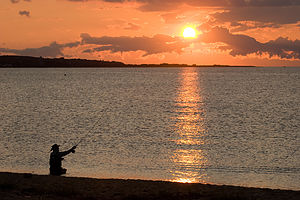 Fly Fishing Lobsterville BeachAlthough the fishing here is really good, the main draw for us are the spectacular sunsets over the Sound. We have also spent many evenings watching the same view from the Menemsha beach, just a stone’s throw (but a 7.5-mile drive) across the channel. Because of its easier accessibility, the Menemsha Beach is mobbed for sunset, while we often have the Lobsterville one practically to ourselves. The other nice thing about being on the Lobsterville side is that it is really nice to look at and photograph the picturesque fishing village of Menemsha from across the channel.
Fly Fishing Lobsterville BeachAlthough the fishing here is really good, the main draw for us are the spectacular sunsets over the Sound. We have also spent many evenings watching the same view from the Menemsha beach, just a stone’s throw (but a 7.5-mile drive) across the channel. Because of its easier accessibility, the Menemsha Beach is mobbed for sunset, while we often have the Lobsterville one practically to ourselves. The other nice thing about being on the Lobsterville side is that it is really nice to look at and photograph the picturesque fishing village of Menemsha from across the channel.
During the summer, a small bike ferry transports cyclists the short distance between Lobsterville and Menemsha. One year, the boys and I took our bikes across on this ferry and then rode the 7.5 miles back to Lobsterville.
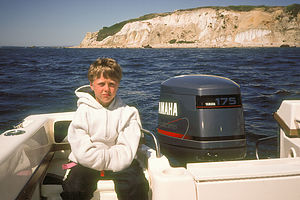 Tommy and Gay Head Cliffs during our Circumnavigation of the VineyardAnother great way to explore the Vineyard is kayaking on one of its many ponds, so a few years ago Herb built a rack for the top of the RV, where he could place two kayaks between the vents and air conditioning unit. It really is rough getting them up and down from there. Thankfully, Herb is in good enough shape to climb up the back ladder with them. Two years ago, we decided to bring the boys’ small perception kayaks to the Vineyard with us. They are pretty wide and slow, but we thought they would be fun to play around with anyway.
Tommy and Gay Head Cliffs during our Circumnavigation of the VineyardAnother great way to explore the Vineyard is kayaking on one of its many ponds, so a few years ago Herb built a rack for the top of the RV, where he could place two kayaks between the vents and air conditioning unit. It really is rough getting them up and down from there. Thankfully, Herb is in good enough shape to climb up the back ladder with them. Two years ago, we decided to bring the boys’ small perception kayaks to the Vineyard with us. They are pretty wide and slow, but we thought they would be fun to play around with anyway.
I bought a really good book called Exploring Martha’s Vineyard by Bike, Foot, and Kayak (see our BOOKS tab), which gave us some great ideas as to where to kayak. One day at Lobsterville, we decided to launch the kayaks in Menemsha Pond and paddle all the way across and then through Nashaquitsa Pond and on to Stonewall Pond, about a 3 to 4 hour paddle. This was a pretty good length voyage, which took us from the Vineyard Sound in the north to a beach on the Atlantic Ocean in the South.
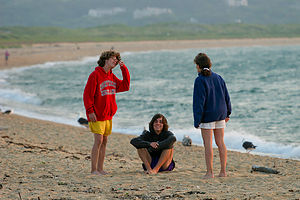 Lolo and Boys at Lobsterville BeachEach of the ponds was very different. Menemsha Pond is pretty busy with boat traffic and quite open and windy, making it a bit of a difficult paddle. However, it is quite scenic and allows you to get up close to Menemsha’s Dutcher Dock. Nashaquitsa Pond is quite a bit smaller and more protected and has lots of coves to explore. Stonewall Pond is even smaller. To get to it we had to paddle under the South Road bridge. The really cool thing about Stonewall Pond is that you can get to a path to Stonewall Beach on the Atlantic Ocean. I read about this is my guide book, so I thought that that gave me permission to ignore the Private No Trespassing signs to check it out. Herb chickened out and stayed with the kayaks. He really missed out, because I got to experience the musical sounds emanating from the surf crashing over the rocks piled up along the base of the cliff. It was mesmerizing.
Lolo and Boys at Lobsterville BeachEach of the ponds was very different. Menemsha Pond is pretty busy with boat traffic and quite open and windy, making it a bit of a difficult paddle. However, it is quite scenic and allows you to get up close to Menemsha’s Dutcher Dock. Nashaquitsa Pond is quite a bit smaller and more protected and has lots of coves to explore. Stonewall Pond is even smaller. To get to it we had to paddle under the South Road bridge. The really cool thing about Stonewall Pond is that you can get to a path to Stonewall Beach on the Atlantic Ocean. I read about this is my guide book, so I thought that that gave me permission to ignore the Private No Trespassing signs to check it out. Herb chickened out and stayed with the kayaks. He really missed out, because I got to experience the musical sounds emanating from the surf crashing over the rocks piled up along the base of the cliff. It was mesmerizing.
The way back was tiring as the wind had shifted against us, but all in all it was a fabulous journey and a very different way of exploring the island. Kayaks definitely do allow you to get into nooks and crannies that would otherwise be inaccessible. There was so much more to do on this island now that kayaks gave us access to the ponds.
Description
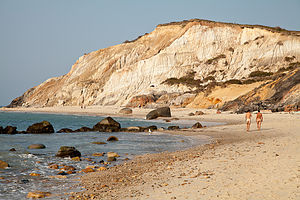 Moshup Beach View of CliffsThe town of Aquinnah is located on the western end of Martha’s Vineyard (referred to as “up-island”), bordered by the Vineyard sound to the north and the Atlantic Ocean to the west and south. It is home to a year round population of 311, half of which are members of the Wampanoag tribe.
Moshup Beach View of CliffsThe town of Aquinnah is located on the western end of Martha’s Vineyard (referred to as “up-island”), bordered by the Vineyard sound to the north and the Atlantic Ocean to the west and south. It is home to a year round population of 311, half of which are members of the Wampanoag tribe.
According to the Wampanoag, Martha’s Vineyard, which they called Noepe, was formed by the giant Moshup and that they arrived on the island by floating on an ice floe from the far North. Moshup then taught his people how to fish and catch whales. The character Tashtego in Herman Melville’s novel Moby Dick was an Aquinnah harpooner.
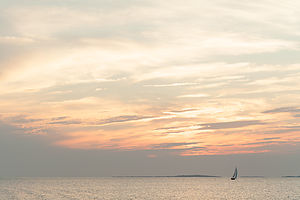 Tacking Across Vineyard SoundThe Wampanoag inhabited Martha’s Vineyard for centuries before Thomas Mayhew, Jr. arrived with a group of settlers in 1642. Mayhew found the Wampanoag to be a courteous and friendly people. He treated them with respect, learned their language, opened the first school on the island to teach them English, and converted many of them to Christianity.
Tacking Across Vineyard SoundThe Wampanoag inhabited Martha’s Vineyard for centuries before Thomas Mayhew, Jr. arrived with a group of settlers in 1642. Mayhew found the Wampanoag to be a courteous and friendly people. He treated them with respect, learned their language, opened the first school on the island to teach them English, and converted many of them to Christianity.
In 1870, the Wampanoag land was incorporated as Gay Head. In 1987, the Federal Bureau of Indian Affairs recognized the Wampanoag tribal council as an official tribal government. The tribal lands encompass 485 acres, 325 of which are common lands, including the Gay Head Cliffs, Herring Creek, and Lobsterville. In 1997, the name of the town was changed from Gay Head to Aquinnah, which means “land under the hill.”
Aquinnah is best known for its dramatically colorful clay cliffs, painted in red, yellow, white, and gray. The cliffs, which are considered sacred to the Wampanoag, are protected, and it is forbidden to climb them or remove the clay.
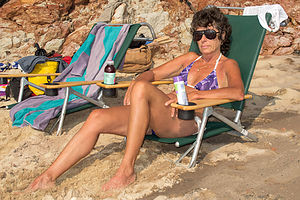 Lolo of Moshup BeachOne of the best vantage points to view the cliffs is from the Gay Head Lighthouse. The lighthouse was opened in 1799 to guide ships through the treacherous waters between the Gay Head Cliffs and the Elizabeth Islands. In 1844 it was moved back 75 feet from the edge of the eroding bluff to its current location. Today the lighthouse is overseen by the Martha’s Vineyard Museum and is open to the public on Friday, Saturday and Sunday evenings from one hour before sunset to a half hour after sunset, from the summer solstice to the fall equinox.
Lolo of Moshup BeachOne of the best vantage points to view the cliffs is from the Gay Head Lighthouse. The lighthouse was opened in 1799 to guide ships through the treacherous waters between the Gay Head Cliffs and the Elizabeth Islands. In 1844 it was moved back 75 feet from the edge of the eroding bluff to its current location. Today the lighthouse is overseen by the Martha’s Vineyard Museum and is open to the public on Friday, Saturday and Sunday evenings from one hour before sunset to a half hour after sunset, from the summer solstice to the fall equinox.
The beach below the cliffs is called Moshup Beach, named after the mythical giant sachem that created the island. While good for swimming, in that the water here is warmer than most of the island, the main draw to this ½-mile white, sandy beach is its incredible scenery. The beach lies at the base of the 130-foot high stunningly beautiful and multicolored Gay Head cliffs, named for its “gay” brightly colored red, brown, yellow, and tan striations. Strolling the beach requires maneuvering over the numerous rocks tossed back and forth by the tides, providing creative beach goers with a limitless supply of materials to build creative rock cairns and towers.
 Moshup Beach Whale Rock?In many parts of the beach, rivulets of red clay seep out of the cliffs and flow towards the ocean. In the 1960’s and 70’s this became a popular spot for nude sunbathers to partake in “clay baths.” Today that is no longer allowed. However, there is still a section of the beach that is clothing optional.
Moshup Beach Whale Rock?In many parts of the beach, rivulets of red clay seep out of the cliffs and flow towards the ocean. In the 1960’s and 70’s this became a popular spot for nude sunbathers to partake in “clay baths.” Today that is no longer allowed. However, there is still a section of the beach that is clothing optional.
Moshup Beach is annually selected by the Travel Channel as one of the top 10 beaches in the nation. Despite its uniqueness and beauty, its remote location from the more touristy parts of the island makes it much less crowded than the other public beaches on the island.
The parking area for the beach is located in the town lot at the end of State Road. It is $15 for the full day. From the parking lot, the Moshup Trail is a 10 minute walk to the beach. For bicyclists, there are bike racks located adjacent to the beach.
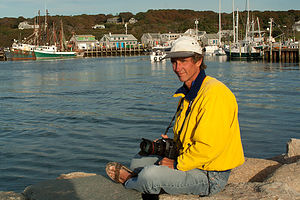 Herb on Lobsterville JettyAbout 4 miles from the Gay Head lighthouse at the end of West Basin Road on the northwest side of the island is Lobsterville Beach, a secluded 2-mile public beach on the calm shores of Vineyard Sound. It is located across a narrow channel, a stone’s throw away from the more highly visited Menemsha village (although the drive there is 7.5 miles). During the summer, a small bike ferry transports cyclists the short distance between Lobsterville and Menemsha.
Herb on Lobsterville JettyAbout 4 miles from the Gay Head lighthouse at the end of West Basin Road on the northwest side of the island is Lobsterville Beach, a secluded 2-mile public beach on the calm shores of Vineyard Sound. It is located across a narrow channel, a stone’s throw away from the more highly visited Menemsha village (although the drive there is 7.5 miles). During the summer, a small bike ferry transports cyclists the short distance between Lobsterville and Menemsha.
Over a hundred years ago, Lobsterville was the most important fishing village on the island. Ships from the mainland sailed into this harbor to purchase lobster and fish. Today, Menemsha has taken its place as the island’s primary fishing port, and Lobsterville village no longer exists.
 Lobsterville Beach SunsetToday Lobsterville is a place for beaching, birding, fishing, and just getting away from the summer crowds. Although swimming is allowed, the rocks and seaweed trapped in the cove make it a bit difficult. Lobsterville’s biggest draw, however, is fishing for flounder, striped bass, bonita, and blues, as dozens of fisherman line the rock jetty just across the channel from their Menemsha competition doing the same.
Lobsterville Beach SunsetToday Lobsterville is a place for beaching, birding, fishing, and just getting away from the summer crowds. Although swimming is allowed, the rocks and seaweed trapped in the cove make it a bit difficult. Lobsterville’s biggest draw, however, is fishing for flounder, striped bass, bonita, and blues, as dozens of fisherman line the rock jetty just across the channel from their Menemsha competition doing the same.
Since Lobsterville is located on the west end of the island, it is a wonderful place to watch the sunset over the water. It’s fun to contrast the quiet viewing that takes place here with the party-like atmosphere of the sunset revelers across the channel on Menemsha Beach. The views of this quaint picturesque village from the Lobsterville jetty make it a great place for photographers as well.
The small parking lot for this beach can accommodate only 8 cars.
There are 2 public beaches in Aquinnah:
- Moshup Beach – located on the Atlantic Ocean at the base of the Gay Head Cliffs
- Lobsterville Beach – located on the Vineyard Sound at the end of West Basin Road
Kayaking opportunities:
- Menemsha – Nashaquitsa – Stonewall Ponds
- Squibnocket Pond
Chilmark
Monday, July 7, 2008 - 12:00pm by Lolo0 miles and 0 hours from our last stop - 1 night stay
Travelogue
 Nashaquitsa Pond DinghiesThe town of Chilmark is probably one of the most beautiful on the island, with its long rambling stone fences and rolling hills overlooking the sea. It’s more of a residential and agricultural community than a touristy one, so we really haven’t done too much in Chilmark, with the exception of driving through it and appreciating its lovely scenery and feeling a bit envious towards anyone fortunate enough to own a home here. Actually, you don’t really see the houses – just the long winding driveways leading towards the sea. It’s the home of the rich and the famous and the place where presidents come to relax.
Nashaquitsa Pond DinghiesThe town of Chilmark is probably one of the most beautiful on the island, with its long rambling stone fences and rolling hills overlooking the sea. It’s more of a residential and agricultural community than a touristy one, so we really haven’t done too much in Chilmark, with the exception of driving through it and appreciating its lovely scenery and feeling a bit envious towards anyone fortunate enough to own a home here. Actually, you don’t really see the houses – just the long winding driveways leading towards the sea. It’s the home of the rich and the famous and the place where presidents come to relax.
One of my favorite viewpoints on the drive through Chilmark is along the South Road. Just about a mile past Beetlebung corner, there is a bridge, with Nashaquitsa Pond on the right and Stonewall Pond on the left. I describe a kayaking trip we took on these two ponds in the Aquinnah stop. About a tenth of a mile after the bridge, the road heads up a hill. Halfway up the hill, there is a wide spot on the side of the road called Quitsa Overlook. From there you can look out over Nashaquitsa and Menemsha ponds and beyond to Menemsha and the Vineyard Sound. One evening when returning from Moshup Beach, Herb and I were lucky enough to catch a beautiful sunset over the ponds.
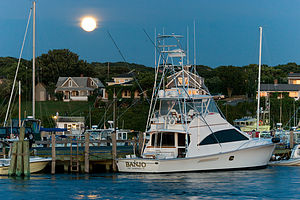 Motor Yacht Banjo by MoonlightMenemsha is one of my favorite places on the island, and one where we have spent many wonderful times. This quaint little fishing village is so picture postcard perfect that it seems more fake than real. In fact, it was used as a stage set during the filming of the movie Jaws.
Motor Yacht Banjo by MoonlightMenemsha is one of my favorite places on the island, and one where we have spent many wonderful times. This quaint little fishing village is so picture postcard perfect that it seems more fake than real. In fact, it was used as a stage set during the filming of the movie Jaws.
I love walking along Dutcher Dock watching the fishermen unload their daily catch of tuna, swordfish, halibut, striped bass, bluefish, and lobster from their weather-beaten fishing boats. It’s a great place to pick up some very fresh seafood at one of the fish markets along the dock.
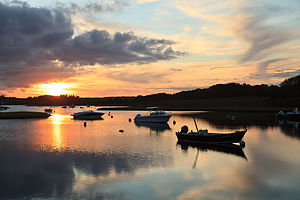 Nashaquitsa Pond SunsetIts location on the northwest part of the island makes Menemsha a perfect place to watch the sunset over the waters of Vineyard Sound. Before we began bringing the RV to the island, we used to come to Menemsha at least once each trip to watch the sunset. Every night is a party in Menemsha as crowds gather on the small swimming beach to watch and cheer as the sun dips below the horizon.
Nashaquitsa Pond SunsetIts location on the northwest part of the island makes Menemsha a perfect place to watch the sunset over the waters of Vineyard Sound. Before we began bringing the RV to the island, we used to come to Menemsha at least once each trip to watch the sunset. Every night is a party in Menemsha as crowds gather on the small swimming beach to watch and cheer as the sun dips below the horizon.
Since we started bringing the RV to the island, we have switched our sunset viewing to Lobsterville Beach, just across the channel from Menemsha. Menemsha is just too crowded to find parking for the RV. I kind of like this better because this way we can gaze at and admire Menemsha from across the channel.
Over the years, we also have done a lot of fishing from the Menemsha rock jetty, which is usually pretty crowded with fisherman trying to land a blue or striper. We have had our fair share of success over the years with many a blue or striper at the end of our lines.
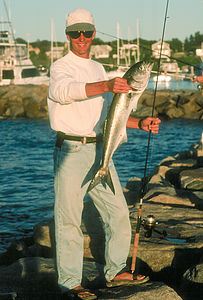 Herb with Nice Bluefish caught on Light Tackle - LEGI remember coming to the Vineyard once in October before Herb and I were married. We came down to Menemsha to watch the sunset and do some fishing. We didn’t have much money then, so we were going to cook dinner on Herb’s camping stove on the jetty. I was not exactly a very good cook then – not that I am that great now – but I was particularly inexperienced at the time. I did not understand the concept of how much rice expands when you cook it. Before I knew it, I had enough rice to feed a family of 10 and it was bubbling over the pot onto the jetty. I think that is when Herb realized he wanted to marry me. Somebody had to do it.
Herb with Nice Bluefish caught on Light Tackle - LEGI remember coming to the Vineyard once in October before Herb and I were married. We came down to Menemsha to watch the sunset and do some fishing. We didn’t have much money then, so we were going to cook dinner on Herb’s camping stove on the jetty. I was not exactly a very good cook then – not that I am that great now – but I was particularly inexperienced at the time. I did not understand the concept of how much rice expands when you cook it. Before I knew it, I had enough rice to feed a family of 10 and it was bubbling over the pot onto the jetty. I think that is when Herb realized he wanted to marry me. Somebody had to do it.
There was about a six-year period where we used to bring our 20-foot Grady White to the island with us. On two of our circumnavigations of the island, we cruised through the channel to explore Menemsha Pond. A couple of times, we anchored and swam to the Lobsterville shoreline where an old dilapidated and abandoned fishing boat lay on its side. We later found out that this was a boat named Orca used in the filming of Jaws. There were two Orcas used in the movie, one for the motor scenes and one for the sinking scenes. This one, as might be obvious, was the one used for the sinking scenes, and it was left behind after the filming was complete. It was there for quite a few years, but I think it is gone now.
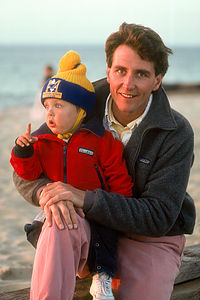 Herb and Andrew watching Menemsha Sunset - LEGMenemsha is also home to the iconic Home Port Restaurant, whose portions are large enough to keep you fed for an entire week. Before RVing days, we always made it a point of coming here at least once on each visit. It’s not a fancy place, but rather a casual waterfront setting with a nautical feel. It has great seafood and no liquor license, so be sure to bring your own.
Herb and Andrew watching Menemsha Sunset - LEGMenemsha is also home to the iconic Home Port Restaurant, whose portions are large enough to keep you fed for an entire week. Before RVing days, we always made it a point of coming here at least once on each visit. It’s not a fancy place, but rather a casual waterfront setting with a nautical feel. It has great seafood and no liquor license, so be sure to bring your own.
We have fond memories of bringing the kids here ever since they were babies. The place is noisy enough to not worry too much about kid behavior. However, one time Tommy, at the age of 2, managed to break through the noise and the chaos and shock the table of elderly women behind us. We had provided him with a blue marker to color the placemat and keep him busy. Without us seeing, he dipped his marker in his water glass, painted his entire mouth blue, stuck his fingers in the mouth stretching his lips apart, and yelled “Look at me, Look at me!!” to the blue-haired ladies behind us. They were not amused. We, however, were and tried our best to not burst out laughing as Herb carried Tommy out of the room to give him a talking to.
Anyway, I highly recommend the Home Port Restaurant.
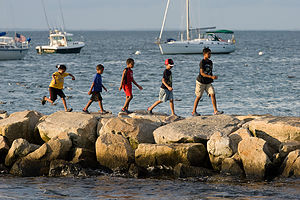 Kids Walking the Menemsha JettyOne summer I decided to not just stick to our usual spots on the island – although they were really good – but to venture out and discover some new ones. That’s when I bought a book called Exploring Martha’s Vineyard by Bike, Foot, and Kayak. It has served me well and brought us to some really cool places, such as the Great Rock Bight Preserve on the northern Vineyard Sound side of Chilmark. Since the RV is not a good vehicle for exploring on the island, we used our bikes to get here from the campground.
Kids Walking the Menemsha JettyOne summer I decided to not just stick to our usual spots on the island – although they were really good – but to venture out and discover some new ones. That’s when I bought a book called Exploring Martha’s Vineyard by Bike, Foot, and Kayak. It has served me well and brought us to some really cool places, such as the Great Rock Bight Preserve on the northern Vineyard Sound side of Chilmark. Since the RV is not a good vehicle for exploring on the island, we used our bikes to get here from the campground.
The Great Rock Bight Preserve is a Martha’s Vineyard Land Bank property. The Land Bank is a very cool concept. Every time a real estate transfer occurs on the island, 2% of the sale goes into a fund which is used to acquire and manage open space for the public’s enjoyment. There are dozens of beautiful spots, some very tiny, some quite large, scattered throughout the island that have been obtained by the Land Bank. You can pick up a map of Land Bank properties at their office on Main Street in Edgartown.
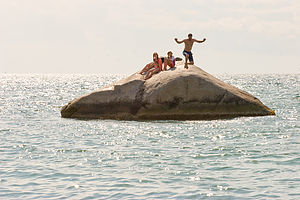 English Family on Great RockAnyway, the 28.5-acre Great Rock Bight Preserve is an excellent example of one of these Land Bank properties that have been set aside for public enjoyment. It is located on the north side of the North Road, about 4 miles west of its intersection with State Road in West Tisbury, which was a pretty good, and hilly, ride from the campground. Once we arrived, we locked our bikes up at the trailhead and set out on the .8-mile Yellow Trail to the beach. The trail brought us to a bluff above the beach with tremendous views of Vineyard Sound and the Elizabeth Islands, as well as the “great rock” standing guard over the cove. We took the steep trail down to the beach, which for now we had totally to ourselves. My biggest regret was that I did not wear a bathing suit under my cycling shorts, because the water was inviting, and the rock would have been a great destination to swim to. Instead, we had to settle for watching another better-equipped family from London arrive, strip down to their bathing suits, and swim out to the rock. We even took a family photo of them standing out on the rock. That was supposed to be my family picture. Next time I would plan better.
English Family on Great RockAnyway, the 28.5-acre Great Rock Bight Preserve is an excellent example of one of these Land Bank properties that have been set aside for public enjoyment. It is located on the north side of the North Road, about 4 miles west of its intersection with State Road in West Tisbury, which was a pretty good, and hilly, ride from the campground. Once we arrived, we locked our bikes up at the trailhead and set out on the .8-mile Yellow Trail to the beach. The trail brought us to a bluff above the beach with tremendous views of Vineyard Sound and the Elizabeth Islands, as well as the “great rock” standing guard over the cove. We took the steep trail down to the beach, which for now we had totally to ourselves. My biggest regret was that I did not wear a bathing suit under my cycling shorts, because the water was inviting, and the rock would have been a great destination to swim to. Instead, we had to settle for watching another better-equipped family from London arrive, strip down to their bathing suits, and swim out to the rock. We even took a family photo of them standing out on the rock. That was supposed to be my family picture. Next time I would plan better.
Chilmark also shares Menemsha, Nashaquitsa, and Stonewall Ponds with the town of Aquinnah. One summer, Herb and I paddled our kayaks across all three of them for a really wonderful journey, which I have described in the Aquinnah stop, because technically we began it from Lobsterville Beach in Aquinnah.
Description
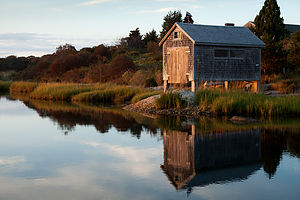 Nashaquitsa Pond BoathouseChilmark is a small, rural community located on the western end (up-island) of Martha’s Vineyard. It is bordered by the Atlantic Ocean on the south, Aquinnah on the west, the Vineyard Sound in the north, and West Tisbury to the east.
Nashaquitsa Pond BoathouseChilmark is a small, rural community located on the western end (up-island) of Martha’s Vineyard. It is bordered by the Atlantic Ocean on the south, Aquinnah on the west, the Vineyard Sound in the north, and West Tisbury to the east.
Less touristy than the rest of the island, it is primarily a residential and agricultural community. With its rolling hills, rambling stone walls, and tall, leafy trees, it is more similar to a Vermont town than the other seaside towns on the island.
The center of town consists of a small schoolhouse, originally a one-room school built in 1850, a tiny post office, and a public library, which often serves as a gathering place for Chilmark’s 650 year-round residents. There is also a love 1843 church and the town hall, built in 1897. Another gathering spot for locals and summer visitors alike is the Chilmark Store, just down the road past Beetlebung Corner. Like Alley’s in West Tisbury, the rocking chairs on the porch are a place to gather for getting the local news and gossip.
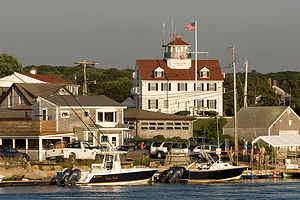 Menemsha Coast Guard StationChilmark was settled by sheep farmers and mariners 300 years ago. A visible reminder of this past is the long stone walls running alongside the roads and through meadows and woods that were once fields for grazing.
Menemsha Coast Guard StationChilmark was settled by sheep farmers and mariners 300 years ago. A visible reminder of this past is the long stone walls running alongside the roads and through meadows and woods that were once fields for grazing.
Earning a livelihood from the sea also lives on in the quaint fishing village of Menemsha, where weathered fishing shacks, nets, buoys, and lobster pots line Dutcher Dock. There is much hustle and bustle in this active port as fisherman in big rubber boots unload their daily catch of tuna, swordfish, halibut, striped bass, bluefish, and lobster from their weather-beaten fishing vessels tied up at the docks. A walk down Dutcher Dock might seem familiar to those who have seen the movie Jaws, as this working fishing harbor served as a stage set for the film.
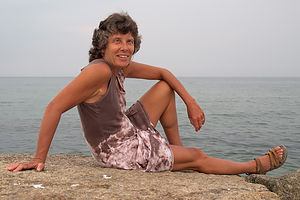 Lolo on JettyMenemsha Village lies on the eastern shore of Menemsha Pond where it flows out into Vineyard Sound. There is a small beach on the calm waters of Vineyard Sound that is great for families with children. Also, popular is surf casting on the rock jetty into the channel leading towards Menemsha Pond. However, what brings most people to Menemsha is the chance to eat some freshly cooked seafood and then watch the spectacular sunset over Vineyard Sound. During the summer, a small bike ferry transports cyclists the short distance across the channel between Menemsha and Lobsterville.
Lolo on JettyMenemsha Village lies on the eastern shore of Menemsha Pond where it flows out into Vineyard Sound. There is a small beach on the calm waters of Vineyard Sound that is great for families with children. Also, popular is surf casting on the rock jetty into the channel leading towards Menemsha Pond. However, what brings most people to Menemsha is the chance to eat some freshly cooked seafood and then watch the spectacular sunset over Vineyard Sound. During the summer, a small bike ferry transports cyclists the short distance across the channel between Menemsha and Lobsterville.
 Dad Fishing Lobsterville at Sunset - AJGChilmark shares several ponds, some of which it shares with neighboring towns: Chilmark Pond in the southeast part of town, Squibnocket and Menemsha Ponds to the southwest (shared with Aquinnah) and Tisbury Great Pond to the east (shared with West Tisbury). The only road to Aquinnah passes between Squibnocket and Menemsha Ponds, which are only 1,100 feet apart.
Dad Fishing Lobsterville at Sunset - AJGChilmark shares several ponds, some of which it shares with neighboring towns: Chilmark Pond in the southeast part of town, Squibnocket and Menemsha Ponds to the southwest (shared with Aquinnah) and Tisbury Great Pond to the east (shared with West Tisbury). The only road to Aquinnah passes between Squibnocket and Menemsha Ponds, which are only 1,100 feet apart.
The town has several sanctuaries and preserves, the largest being the Menemsha Hills Reservation, a 211-acre preserve managed by the Trustees of the Reservation. It is located on the north side of North Road, one mile east of Menemsha Village. Three miles of hiking trails lead through wetlands and woodland groves and a climb to the top of the 308-foot Prospect Hill, the second highest point on the Vineyard.
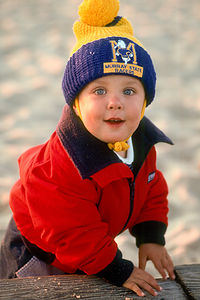 Young Andrew at Menemsha BeachAnother interesting public property in Chilmark is the Great Rock Bight Preserve, a 28.5-acre Martha’s Vineyard Land Bank property with hiking trails and swimming at a secluded sandy cove on Vineyard Sound. The preserve gets its name from the “great rock” located a short, swimmable distance from the beach. The preserve is located on the north side of North Road, 3.8 miles west of its intersection with State Road in West Tisbury. From the parking area, one can go left and take the .5-mile Yellow Trail directly to the beach, or for the more adventurous hiker, the 1.5-mile Marl Pond Loop heads right from the parking area, through grasslands and past two ponds before meeting up with the Yellow Trail towards the beach. From the bluff above the beach there are tremendous views of Vineyard Sound and the Elizabeth Islands, as well as the “great rock” standing guard over the cove. A steep trail leads down to the swimming beach.
Young Andrew at Menemsha BeachAnother interesting public property in Chilmark is the Great Rock Bight Preserve, a 28.5-acre Martha’s Vineyard Land Bank property with hiking trails and swimming at a secluded sandy cove on Vineyard Sound. The preserve gets its name from the “great rock” located a short, swimmable distance from the beach. The preserve is located on the north side of North Road, 3.8 miles west of its intersection with State Road in West Tisbury. From the parking area, one can go left and take the .5-mile Yellow Trail directly to the beach, or for the more adventurous hiker, the 1.5-mile Marl Pond Loop heads right from the parking area, through grasslands and past two ponds before meeting up with the Yellow Trail towards the beach. From the bluff above the beach there are tremendous views of Vineyard Sound and the Elizabeth Islands, as well as the “great rock” standing guard over the cove. A steep trail leads down to the swimming beach.
The Chilmark Pond Preserve is a Martha's Vineyard Landbank property with walking trails and a canoe/kayak launch site that allows for access to Lower Chilmark Pond. There is also a 200-feet beach accessible by canoe or kayak. A boardwalk and stairs lead from the pond to the beach.
There are 3 public beaches in Chilmark:
- Menemsha Public Beach – gentle beach on the Vineyard Sound next to Menemsha Harbor
- Chilmark Pond Preserve – 200-foot beach accessible by canoe or kayak
- Great Rock Bight Preserve – located off the North Road. The trail to the beach is long and steep and has stairs.
Kayaking opportunities:
- Chilmark Pond
- Menemsha – Nashaquitsa – Stonewall Ponds
- Squibnocket Pond
West Tisbury
Sunday, July 6, 2008 - 12:00pm by Lolo0 miles and 0 hours from our last stop - 1 night stay
Travelogue
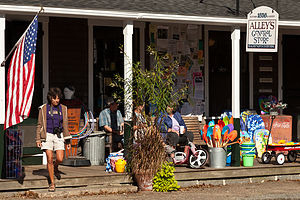 Lolo at Alley's General StoreWest Tisbury has a very different feel to it than the other towns on the island. It’s more similar to a small New England farming community than the other seaside towns on the island. The Old Grange Hall holds a farmers’ and craft market every Wednesday afternoon and Saturday morning, and the new Agricultural Hall is the site of the annual Vineyard County fair held in the third week of August. I have never been to it, but it is definitely on my bucket list to do so some day. If I were to live on the island, I could most easily picture living here.
Lolo at Alley's General StoreWest Tisbury has a very different feel to it than the other towns on the island. It’s more similar to a small New England farming community than the other seaside towns on the island. The Old Grange Hall holds a farmers’ and craft market every Wednesday afternoon and Saturday morning, and the new Agricultural Hall is the site of the annual Vineyard County fair held in the third week of August. I have never been to it, but it is definitely on my bucket list to do so some day. If I were to live on the island, I could most easily picture living here.
Usually, West Tisbury is not a destination for us, but rather a place we pass through on our way to Lobsterville, Menemsha, or Moshup Beach. That being said, we do have some favorite spots, the first of which is Alley’s General Store and the Field Gallery across the street. Alley’s is kind of a gathering place for locals to sit on the porch and get the day’s news and gossip. The store itself is pretty basic in terms of supplies – a few grocery items, some beach stuff, and lots of nosh. When they were little, the boys used to love to stop and shop here.
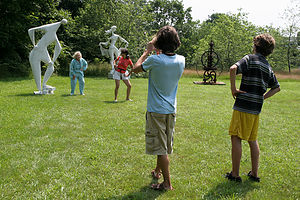 Family with Aggy Imitating Field Gallery ArtThe Field Gallery, with its whimsical statues of women dancing, just across the street is one of my favorite stops. A few summers after my father passed away, we used to bring my 80+ year old mom to the island with us. Probably some of my all-time favorite photos of all times are the ones of my mother imitating the poses of these statues.
Family with Aggy Imitating Field Gallery ArtThe Field Gallery, with its whimsical statues of women dancing, just across the street is one of my favorite stops. A few summers after my father passed away, we used to bring my 80+ year old mom to the island with us. Probably some of my all-time favorite photos of all times are the ones of my mother imitating the poses of these statues.
Also, one of the largest and nicest galleries on the island is the Granary Gallery at the Red Barn on Old County Road. We try to stop there every year now and look at their very fine collection of paintings, sculptures, and photographs. If I had unlimited money, I would definitely decorate my house with many pieces from this must-see gallery.
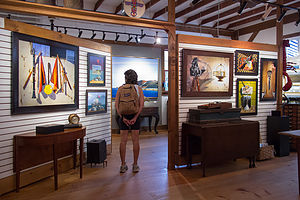 Lolo in Granary GalleryLike most of the towns on the island, West Tisbury also has its share of refuges and reservations. One of the ones we discovered a few years back is Sepiessa Point, a Land Bank property on the Tisbury Great Pond. Much of the roads on the island, especially those leading to the ponds, are dirt, so the RV is not a very practical vehicle for exploring. That is why the bikes have become such an important part of our Vineyard explorations. Sepiessa has a 2 ½ mile bike trail that leads to a beautiful sandy beach on the pond, shallow, but still nice for swimming. You just have to be careful about stepping on a sharp oyster shell, of which the pond has many. Across the pond you can see the ocean side barrier beach. Twice a year a breach is created to allow salt water to flow into the pond because oysters need salt water to breed.
Lolo in Granary GalleryLike most of the towns on the island, West Tisbury also has its share of refuges and reservations. One of the ones we discovered a few years back is Sepiessa Point, a Land Bank property on the Tisbury Great Pond. Much of the roads on the island, especially those leading to the ponds, are dirt, so the RV is not a very practical vehicle for exploring. That is why the bikes have become such an important part of our Vineyard explorations. Sepiessa has a 2 ½ mile bike trail that leads to a beautiful sandy beach on the pond, shallow, but still nice for swimming. You just have to be careful about stepping on a sharp oyster shell, of which the pond has many. Across the pond you can see the ocean side barrier beach. Twice a year a breach is created to allow salt water to flow into the pond because oysters need salt water to breed.
For those interested in history, Christiantown is a very interesting place to visit. Like many other hidden gems on the island, its location at the end of a dirt road made the bikes the best choice for getting there. It’s not actually all that easy to find. To get there, when traveling west on the State Road, turn right onto Indian Hill Road, follow that for ½ a mile, and then turn right onto the dirt Christiantown Road. There may not be a street sign, but only a Private Road sign – very inviting. Follow that for another .6 miles to a parking lot.
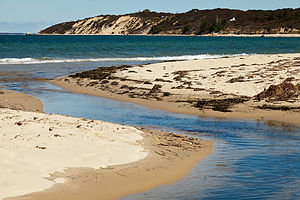 Lamberts Cove RivuletYou’ll know you’re there when you see the tiny Mayhew Chapel, named after the Reverend Thomas Mayhew Jr., who was instrumental in converting the Wampanoag tribe to Christianity. Hence the name Christiantown, which was established in 1659 when Sachem Josias Keteanummin donated a square-mile plot of land to be used as a the first native American Christian settlement. The small wooden Mayhew Chapel is only open on Sundays, but you can peek through the windows at its tiny altar and six pews. The chapel was named after the Reverend Thomas Mayhew Jr., who was instrumental in converting the Wampanoags to Christianity.
Lamberts Cove RivuletYou’ll know you’re there when you see the tiny Mayhew Chapel, named after the Reverend Thomas Mayhew Jr., who was instrumental in converting the Wampanoag tribe to Christianity. Hence the name Christiantown, which was established in 1659 when Sachem Josias Keteanummin donated a square-mile plot of land to be used as a the first native American Christian settlement. The small wooden Mayhew Chapel is only open on Sundays, but you can peek through the windows at its tiny altar and six pews. The chapel was named after the Reverend Thomas Mayhew Jr., who was instrumental in converting the Wampanoags to Christianity.
Behind the chapel there is a short trail leading through the Christiantown Woods, where you will pass the remnants of farms that occupied this land centuries ago.
Just across the road from the chapel is a small hill. Follow that to a small burial ground, where the remains of the Wampanoag converts lie. The grave markers contain no names or information about who is buried below.
Indian Hill Road leads back out to Lamberts Cove Road and to what is one of the most beautiful beaches on the island. James Taylor and Carly Simon co-wrote a song called Terra Nova, and at the end of it she sings about what has come to be known as “Lambert’s Cove.”
Out of the west of Lambert's Cove
There's a sail out in the sun
And I'm on board though very small
I've come home to stop yearning
Burn off the haze around the shore
Turn off the crazy way I feel
I'll stay away from you no more
I've come home to stop yearning
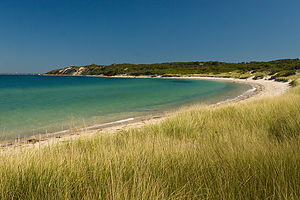 Lamberts Cove BeachUnfortunately, only residents of the town of West Tisbury, of which Carly Simon is one, are allowed access to this beautiful beach during the summer. The rest of us have to wait until the off season to not be chased off its pristine shore. We often do come to the Vineyard in late September, so we chose one fine sunny Indian summer day to enjoy this lovely beach. My favorite part of the beach, and the place in which I and a few other sea birds chose to take a dip, was the little rivulet that flows back and forth between the James Pond and Vineyard Sound. It truly is a place worth singing about.
Lamberts Cove BeachUnfortunately, only residents of the town of West Tisbury, of which Carly Simon is one, are allowed access to this beautiful beach during the summer. The rest of us have to wait until the off season to not be chased off its pristine shore. We often do come to the Vineyard in late September, so we chose one fine sunny Indian summer day to enjoy this lovely beach. My favorite part of the beach, and the place in which I and a few other sea birds chose to take a dip, was the little rivulet that flows back and forth between the James Pond and Vineyard Sound. It truly is a place worth singing about.
Description
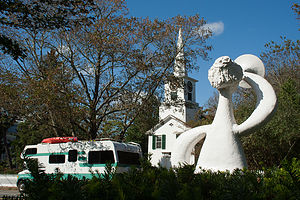 Field Gallery Art with Lazy Daze - LEGWest Tisbury is located in the center of the island. It is bordered by the Atlantic Ocean to the south, Chilmark to the west, Vineyard sound to the northwest, Tisbury to the northeast, and Edgartown to the east. Along with its neighbors Chilmark and Aquinnah, it is considered to be up-island.
Field Gallery Art with Lazy Daze - LEGWest Tisbury is located in the center of the island. It is bordered by the Atlantic Ocean to the south, Chilmark to the west, Vineyard sound to the northwest, Tisbury to the northeast, and Edgartown to the east. Along with its neighbors Chilmark and Aquinnah, it is considered to be up-island.
Having no port, West Tisbury is more similar to a typical New England farming community than to the other seaside towns on the island. It is the agricultural heartland of the island. The old Grange Hall on the corner of Music Street hosts a farmers’ and craft market on Wednesday afternoons and Saturday mornings. The new Agricultural Hall, one mile from the old hall, is the site of one of the Vineyard’s most popular events, the annual County Fair held in the third week of August.
 Tommy at Llama FarmTime seems to move a bit slower in this traditional farming community. Locals frequently gather on the porch of Alley’s General Store to get the day’s news, drink coffee, and glare at the tourists. Fans of Cynthia Riggs’ mystery stories will recognize many places in town from her books, including the tiny one-room police station on Mill Pond.
Tommy at Llama FarmTime seems to move a bit slower in this traditional farming community. Locals frequently gather on the porch of Alley’s General Store to get the day’s news, drink coffee, and glare at the tourists. Fans of Cynthia Riggs’ mystery stories will recognize many places in town from her books, including the tiny one-room police station on Mill Pond.
West Tisbury is home to several Vineyard artists, many of which have galleries in their homes. The Field Gallery, with its whimsical dancing statues by artist Tom Maley, is located across the street from Alley’s General Store. One of the largest and nicest galleries on the island is the Granary Gallery at the Red Barn on Old County Road.
 Field Gallery SculptureThe town also has several refuges and reservations, the largest being the Long Point Wildlife Refuge just east of Tisbury Great Pond. The Refuge, which includes over 600 acres of beach, dune, and woodland, is managed by the Trustees of Reservation. It is one of the largest publicly accessible properties on the island. There are 2.1 miles of flat trails through woods and open areas that lead to an ocean-side beach.
Field Gallery SculptureThe town also has several refuges and reservations, the largest being the Long Point Wildlife Refuge just east of Tisbury Great Pond. The Refuge, which includes over 600 acres of beach, dune, and woodland, is managed by the Trustees of Reservation. It is one of the largest publicly accessible properties on the island. There are 2.1 miles of flat trails through woods and open areas that lead to an ocean-side beach.
The Cedar Tree Neck Sanctuary, a 300-acre natural habitat owned by the Sheriff’s Meadow Foundation, is located on the island’s northern shore along Vineyard Sound. Three separate trails take visitors through woods, across streams, past freshwater ponds and bogs, along rocky bluffs with scenic views, and along a beach.
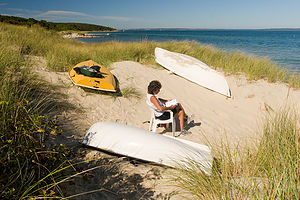 Lolo reading in Lamberts Cove DuneThe Sepiessa Point Reservation is a 173.7-acre Martha’s Vineyard Land Bank property located in the town of West Tisbury on the Tisbury Great Pond. The reservation has 2.5 miles of hiking/biking trails and a half-mile-long sandy beach from which one can swim in the pond. The pond is oyster seeded, so there are sharp shells scattered along the beach and in the water. Since oysters need salt water to breed, twice a year a breach is created in the barrier beach to allow salt water to flow into the pond.
Lolo reading in Lamberts Cove DuneThe Sepiessa Point Reservation is a 173.7-acre Martha’s Vineyard Land Bank property located in the town of West Tisbury on the Tisbury Great Pond. The reservation has 2.5 miles of hiking/biking trails and a half-mile-long sandy beach from which one can swim in the pond. The pond is oyster seeded, so there are sharp shells scattered along the beach and in the water. Since oysters need salt water to breed, twice a year a breach is created in the barrier beach to allow salt water to flow into the pond.
West Tisbury is also home to approximately half of the Manuel F. Correllus State Forest, which dominates the center of the island. The other half lies in Edgartown. The State Forest is described in a separate stop.
An interesting historical site in West Tisbury is the Christiantown Memorial, the site of the Mayhew Chapel and a small Indian burial ground. Christiantown was established in 1659 as the first Christian Native American village. The chapel that stands there today was built in 1829. Inside there is a tiny altar and six pews.
There are four public beaches in West Tisbury
- Long Point Wildlife Refuge Beach – located on the south shore and open to non-residents who purchase a Trustees of the Reservation sticker
- Sepiessa Point Reservation – the ocean beach can only be reached via kayak or canoe
- Uncle Seth’s Pond – small beach on a pond on Lambert’s Cove Road
- Lambert’s Cove – considered by many to be the most beautiful beach on the island. It is located off Lambert’s Cove Road and is situated on a cove off of Vineyard Sound. During the summer, only residents of West Tisbury and their guests are allowed to use the beach.
Kayaking opportunities:
- Tisbury Great Pond
Manuel F. Correllus State Forest
Saturday, July 5, 2008 - 11:45am by Lolo0 miles and 0 hours from our last stop - 1 night stay
Travelogue
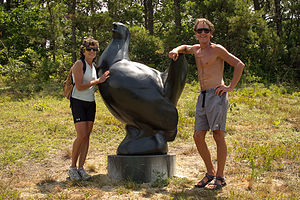 Lolo and Herb with Booming Ben SculptureAlthough the State Forest is technically part of Edgartown and West Tisbury, I felt that it was unique enough to warrant its own stop. Its 5,100 acres take up a major part of the center of the island.
Lolo and Herb with Booming Ben SculptureAlthough the State Forest is technically part of Edgartown and West Tisbury, I felt that it was unique enough to warrant its own stop. Its 5,100 acres take up a major part of the center of the island.
We have come to the forest many times to bike its 15 miles of trails, some of which parallel the roads, but others that take you through the heart of the forest. One time Herb and I even roller bladed the trails while the kids biked. Although the island is flat, there are quite a bit of roller coaster ups and downs along this trail.
There is even a 27-basket Frisbee golf course, located inside the forest on Barnes Road near the airport. A few years back, we bought some discs for the boys in a shop in Edgartown. For those unfamiliar with the game, it is played similar to golf, but instead of hitting a golf ball, one throws a special type of Frisbee (called a disc). The object is to get the disc into a raised basket in as few throws as possible. The other object, we soon found, was to not land a poorly thrown disc in the poison ivy that grows quite bountifully throughout the forest. It was pretty fun, but completing all 27 holes can take a very long time, so we usually choose a shortened version.
I wish I had researched the background of this state forest earlier. We have been coming to it for over 30 years, but it wasn’t until this year – when I finally decided to do a writeup on Martha’s Vineyard – that I discovered its interesting history.
The Massachusetts Department of Conservation and Recreation is working on trying to restore the park’s native ecosystem in what is one of the largest environmental restoration projects in the country. The park is part of the Atlantic coastal pine barrens ecoregions and includes grasslands, heathlands, pine barrens, and woodlands. It was originally set aside as a preserve in 1908 in an attempt to save the endangered heath hen, an eastern subspecies of the prairie chicken, which had died out in most other areas of the northeast.
The rest is a very sad story. At first things were going pretty well, and the heath hen population grew from 70 to 2,000. However, a few bad years of forest fires and severe winters reduced the population to only 12. By the next year there was only one poor male heath hen left. Okay, now here comes the really sad part. He is nicknamed Booming Ben, because he used to perch himself atop an oak tree and let out his mating call, which raises the question, “if a heath hen booms in the forest, but no female heath hen hears it, does it make a sound?” Boomer lived on another four or so years by himself before passing in 1932, making the heath hen species extinct.
I really would have liked to have known about this story earlier. From now on, I am going to do more heavy research upfront, so I can get the full enjoyment out of a stop and not just save that for my readers.
On our most recent trip to the Vineyard in 2012, we made it a mission to find the Heath Hen Sculpture put here in 2011 by the artist Todd McGrain. We found it, just out there along the path through the forest in the spot where Boomer (as Herb was now calling him) was last seen – about a 10-minute walk from Gate 18 or 19 on the West Tisbury-Edgartown Road. It certainly made me view the forest quite differently—not as just a place for recreation, but as a home to a broad range of species, some of which are quite rare.
It is really a lovely and serene place, and so different from the rest of the island. That is one thing that I definitely have to say about Martha’s Vineyard. There is so much diversity in landscapes that you can achieve a lot more variety of experiences than you would expect on a small island.
Description
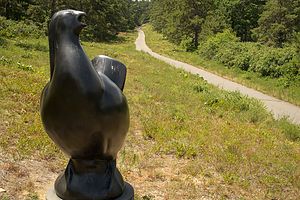 "Boomer" and State Forest TrailThe Correllus State Forest is a 5,100-acre preserve in the center of Martha’s Vineyard, managed by the Department of Conservation and Recreation. Its main attraction is the 15 miles of bike paths through lovely woodlands.
"Boomer" and State Forest TrailThe Correllus State Forest is a 5,100-acre preserve in the center of Martha’s Vineyard, managed by the Department of Conservation and Recreation. Its main attraction is the 15 miles of bike paths through lovely woodlands.
The preserve was created in 1908 as a sanctuary for the endangered heath hen, an eastern subspecies of the prairie chicken, which had died out in most other areas of the northeast. At first efforts were successful and the heath hen population grew from 70 to 2,000. However, as a results of forest fires and severe winters, by 1927 there were only 12 heath hens left in the world, all in the Correllus State Forest. By the following year there was only one male heath hen left, nicknamed Booming Ben, because of the way he would sit perched atop an oak tree futiley emitting the heath hen mating call. Sadly, there were no female heath hens to hear his plea. When Booming Ben disappeared in 1932, the species that had once been a source of food for settlers from Virginia to Maine was now extinct. In June of 2011, Sculptor Todd McGrain’s Heath Hen Sculpture was dedicated and placed in the forest near where Booming Ben was last seen. The sculpture can be found by taking a 10-minute walk from Gate 18 or 19 on the West Tisbury-Edgartown Road.
In 1934 the Civilian Conservation Corps planted red pine, white pine, and spruce trees to an area that had become a sandplain grassland because of frequent fires. While the white pine and spruce trees are still flourishing, the red pine, which thrives in colder climates, is dying out. Today the forest is the focus of one of the largest environmental restoration projects in the nation as work is done to restore it to its native ecosystem.
Bicycling, hiking, or rollerblading through the state forest is a wonderful way to get away from the crowds that descend on the island during the summer months. The following is a link to the state forest’s trail map: http://www.mass.gov/dcr/parks/trails/corellus600.gif
As an added attraction is the 27-basket disc (Frisbee) golf course located inside the forest on Barnes Road near the airport. For those unfamiliar with the game, it is played similar to golf, but instead of hitting a golf ball, one throws a special type of Frisbee (called a disc). The object is to get the disc into a raised basket in as few throws as possible.
Chappaquiddick
Friday, July 4, 2008 - 11:15am by Lolo0 miles and 0 hours from our last stop - 1 night stay
Travelogue
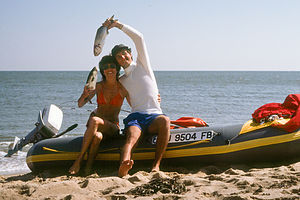 "Kissing Bluefish" on Avon Raft during HoneymoonFor a place so small, this tiny island off an island is so jam packed with wonderful memories that I don’t know where to start, so I guess I will start at the beginning.
"Kissing Bluefish" on Avon Raft during HoneymoonFor a place so small, this tiny island off an island is so jam packed with wonderful memories that I don’t know where to start, so I guess I will start at the beginning.
The very first time I came to Martha’s Vineyard was in 1979, when Herb and I and another couple took our bikes on the Ferry and bicycled to Edgartown to spend a night at the very lovely Edgartown Inn. As we sat by the Wharf that evening, I became intrigued by the small ferry endlessly chugging back and forth across the 100 yard or so channel between Edgartown and a dark beach a stone’s throw away. Without knowing, nor for that matter caring, what lied on the other side, I turned to Herb and said, “Let’s get on the ferry.” Always the pragmatic engineer, Herb’s simple reply was, “Why?” I was very tempted to use the punch line from a chicken joke.
 Herb and baby Andrew Tailgating in back of Isuzu TrooperI might not have gotten to ride the On Time Ferry that evening, but we’ve more than made up for it over the past three decades of Vineyard adventures. Also, somewhat ironically, 16 years after that first trip to the island, Herb and I got married in Edgartown and spent our first night as a married couple in that very same Edgartown Inn (more on the wedding in the Edgartown stop).
Herb and baby Andrew Tailgating in back of Isuzu TrooperI might not have gotten to ride the On Time Ferry that evening, but we’ve more than made up for it over the past three decades of Vineyard adventures. Also, somewhat ironically, 16 years after that first trip to the island, Herb and I got married in Edgartown and spent our first night as a married couple in that very same Edgartown Inn (more on the wedding in the Edgartown stop).
Before we bought the RV in 1999, our Suburban was our vehicle of choice, primarily because it is 4-wheel drive and can be driven on the Chappaquiddick beaches. The pass is not cheap though. Although it was probably under $100 for an annual over-sand pass back when we were buying it, it is now something like $180 for non-member, non-island residents. If you become a member of the Trustees of the Reservation, however, it is a bit cheaper. Whatever the cost, it is certainly worth it. Some of my fondest Vineyard memories are of cruising along the beach with Carly Simon waling on the stereo.
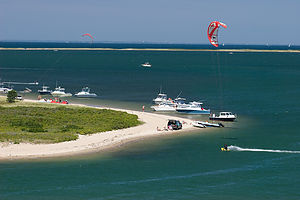 Kite Boarders at the GutAlthough four-wheel driving is the quickest and most convenient way to set up for a day of fishing at one of Chappaquiddick’s world-class fishing spots, it is not the only way. For years, I have chosen to do it on two wheels, because bicycling is also a great way to explore Chappaquiddick. Since we generally stayed at a house out on Katama (Edgartown), this involved about a 7 mile drive, over a mile of which is on sand. Now this might not seem like a big deal, but throw two small boys on Toys R Us bikes into the equation and things get a bit more interesting. Since it is nice to have all your stuff at the beach—coolers, fishing rods, beach chairs, toys, etc.—Herb would drive there in the Suburban and the boys and I would meet him later.
Kite Boarders at the GutAlthough four-wheel driving is the quickest and most convenient way to set up for a day of fishing at one of Chappaquiddick’s world-class fishing spots, it is not the only way. For years, I have chosen to do it on two wheels, because bicycling is also a great way to explore Chappaquiddick. Since we generally stayed at a house out on Katama (Edgartown), this involved about a 7 mile drive, over a mile of which is on sand. Now this might not seem like a big deal, but throw two small boys on Toys R Us bikes into the equation and things get a bit more interesting. Since it is nice to have all your stuff at the beach—coolers, fishing rods, beach chairs, toys, etc.—Herb would drive there in the Suburban and the boys and I would meet him later.
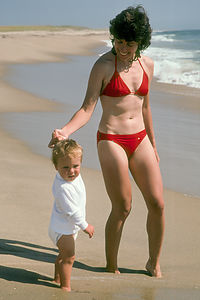 Lolo and Andrew on the BeachWhen the boys were little, I always tried to encourage them to bicycle everywhere we could on the island. We even bought them little speedometers so they could keep track of how far they went. They would reset them at the beginning of the vacation so that they could see how far they had ridden. Near the end of one two-week trip, we found Andrew obsessively driving round and round the circle of the cul-de-sac where we were staying so that he could reach 100 miles—a pretty impressive accomplishment for an 8 year old.
Lolo and Andrew on the BeachWhen the boys were little, I always tried to encourage them to bicycle everywhere we could on the island. We even bought them little speedometers so they could keep track of how far they went. They would reset them at the beginning of the vacation so that they could see how far they had ridden. Near the end of one two-week trip, we found Andrew obsessively driving round and round the circle of the cul-de-sac where we were staying so that he could reach 100 miles—a pretty impressive accomplishment for an 8 year old.
I also never hesitated to stoop to bribery to get through what the boys began referring to as “Mommy boot camp.” “Only two more miles to Mrs. Miller’s muffins,” was a common technique. “Just a little more till the Quarterdeck where I will buy you a frappe.” It wasn’t pretty, but it worked. I would have to say that when we finally arrived and greeted Herb and his fellow fishermen on the beach, the boys strutted a bit more proudly for having gotten there on their own power.
The beaches of Chappy are managed by the Trustees of Reservations, a non-profit, land conservation and historic preservation organization in Massachusetts. The Cape Poge Wildlife Refuge, as it is called, extends seven miles from Wasque Point on the south, all the way past the Cape Poge Lighthouse to the Cape Poge Gut. While a four-wheel drive vehicle allows you to go all the way from Wasque to the Gut—which is a very bumpy, but scenic drive, which we have done several times in the past—bicyclists must choose either East Beach or Wasque, as these are the only places that roads will take you.
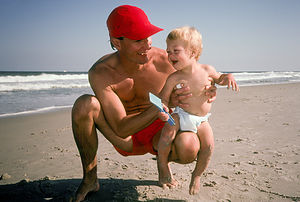 Herb Entertaining Tommy at East BeachThere is only one paved road on the island (Chappaquiddick Road), so when you get off the On Time Ferry there is not a whole lot of deciding where to go.
Herb Entertaining Tommy at East BeachThere is only one paved road on the island (Chappaquiddick Road), so when you get off the On Time Ferry there is not a whole lot of deciding where to go.
About 1.3 miles from the ferry, on the left, is North Neck Road, a dirt road leading 1.1 miles out to the trailhead for the North Neck Highlands Preserve, a property of the Martha’s Vineyard Land Bank. The trail leads to a tremendous view from the highlands out over Cape Poge Bay and “the Gut,” an area very popular for fishing, as well as windsurfing and kiteboarding. The only way back from this point, is to retrace your steps back to Chappaquiddick Road.
In 1999 (our last trip without RV), we rented a house with my brother’s family on these highlands overlooking Cape Poge Bay. It was a tremendous house with unparalleled views of “the Gut” and Edgartown in the distance. Each home on the bluff has a steep staircase leading down to a very narrow and somewhat rocky beach. We kept our kayaks on the beach and used them to make the short crossing over to the sandspit on the other side of “the Gut”. However, the winds were particularly strong, making what should have been a very easy paddle into something a bit more challenging.
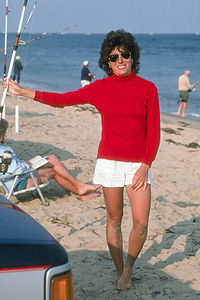 Lolo of Wasque in RedMy brother Jim is an early riser, and each morning before the rest of us awoke, he would head down the staircase to the beach with his coffee and fishing rod. One morning he proudly returned telling us of the fish he had caught while we were all slumbering. I really loved the views from that house. We even spent the 4th of July that summer watching the fireworks over Edgartown Harbor from our deck. Rumor has it that Lady Gaga has bought a vacation home right near to this one.
Lolo of Wasque in RedMy brother Jim is an early riser, and each morning before the rest of us awoke, he would head down the staircase to the beach with his coffee and fishing rod. One morning he proudly returned telling us of the fish he had caught while we were all slumbering. I really loved the views from that house. We even spent the 4th of July that summer watching the fireworks over Edgartown Harbor from our deck. Rumor has it that Lady Gaga has bought a vacation home right near to this one.
We have returned to “the Gut” several times since that year, sometimes on our Grady White and once by kayak. In fact, Andrew caught his first striper from our Grady in the churned up waters at the entrance to the Bay. Herb was convinced it was just the current tugging at his line, until he hauled a nice size striper onto the boat.
2012 was the first year that Herb and I had our new kayaks on the island. We decided to paddle from State Beach in Edgartown across the Harbor and into “the Gut,” about a 5 mile paddle each way. I never understand how wind can always be against you, because that is exactly what happened that day, and it was a strong one. The trip there wasn’t as bad, probably because I wasn’t completely exhausted yet, but the entrance to “the Gut” was pretty scary. There were these standing waves that kept churning and churning in place, and it is easy to get caught up in them. I must say I had to use a very significant chunk of my allotted energy for the day to just get through them. However, the rewards afterwards were great as we pulled over to the beach (just across the way from our wonderful rental house of 1999) and lounged on the beach for a few hours.
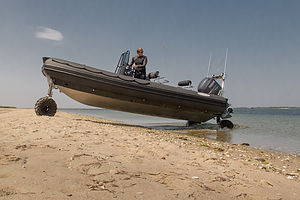 007 Inflatable Amphibious Boat at the GutA very unusual thing happened when we were on the beach. An all black rigid-hulled inflatable boat with a single man on board entered the Bay. As he approached us, he lowered a wheel at the front of the boat and two in back and proceeded to drive up onto the beach. We had never seen anything like it. Next, he set up a kiteboard—also all black—and started skillfully whipping around the bay. I felt like we were watching a James Bond movie. Herb later spoke to him and learned a bit more about amphibious rigid-hulled boats, of which this was one. They can even be driven on the road, which this guy does to get it from the marina in Edgartown to his home. Very cool.
007 Inflatable Amphibious Boat at the GutA very unusual thing happened when we were on the beach. An all black rigid-hulled inflatable boat with a single man on board entered the Bay. As he approached us, he lowered a wheel at the front of the boat and two in back and proceeded to drive up onto the beach. We had never seen anything like it. Next, he set up a kiteboard—also all black—and started skillfully whipping around the bay. I felt like we were watching a James Bond movie. Herb later spoke to him and learned a bit more about amphibious rigid-hulled boats, of which this was one. They can even be driven on the road, which this guy does to get it from the marina in Edgartown to his home. Very cool.
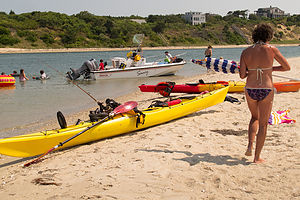 Lolo and Kayaks at the GutI was really hoping that the wind would die down a bit before we had to make the voyage back to State Beach, but it seemed to only be getting stronger. Although Herb tried to convince me to take the straight line—and thus the shortest distance—across the harbor to our destination, I was too scared to go back out in open water. I preferred to hug the shoreline, even if it meant going further. Also, I have noticed that when kayaking, the closer to shore you are, the faster it seems you are going, even if that isn’t true. You can kind of tick off distances—I just have to get to that dock, then just a little further to that boat, etc., etc. I remember almost crying at one point when my mini goal was to paddle from one dock to the next and I looked to my left only to find that dock wasn’t moving, or more correctly, I wasn’t moving in relation to it. I was just rowing in place, and if I stopped paddling for a minute, I would actually go backwards. The only way I could make progress was to paddle really, really hard—faster than the current and the winds against me. I admit to being a bit scared and a lot cranky. Herb was lucky he wasn’t to near me or he wouldn’t have like what I was calling him. Obviously, we did finally make it. I was never so happy to be at State Beach.
Lolo and Kayaks at the GutI was really hoping that the wind would die down a bit before we had to make the voyage back to State Beach, but it seemed to only be getting stronger. Although Herb tried to convince me to take the straight line—and thus the shortest distance—across the harbor to our destination, I was too scared to go back out in open water. I preferred to hug the shoreline, even if it meant going further. Also, I have noticed that when kayaking, the closer to shore you are, the faster it seems you are going, even if that isn’t true. You can kind of tick off distances—I just have to get to that dock, then just a little further to that boat, etc., etc. I remember almost crying at one point when my mini goal was to paddle from one dock to the next and I looked to my left only to find that dock wasn’t moving, or more correctly, I wasn’t moving in relation to it. I was just rowing in place, and if I stopped paddling for a minute, I would actually go backwards. The only way I could make progress was to paddle really, really hard—faster than the current and the winds against me. I admit to being a bit scared and a lot cranky. Herb was lucky he wasn’t to near me or he wouldn’t have like what I was calling him. Obviously, we did finally make it. I was never so happy to be at State Beach.
I got a bit off track, but I guess my point is no matter what means of transport, “the Gut” is definitely an interesting and worthwhile destination.
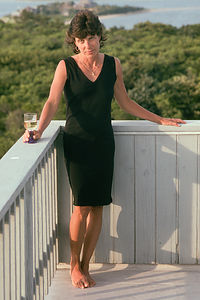 Lolo in Black Dress on Deck of "Gut House"Once back out on Chappaquiddick Road, another 0.3 miles (1.6 miles from the ferry) past North Neck Road brings you to the Brine’s Pond Preserve, a Martha’s Vineyard Land Bank property, located on the right side of the road, just past the Chappaquiddick Community Center. It’s a pretty little spot, nice for a rest and a brief stroll along the trail around the pond. The most notable feature of the Preserve is an island of beetlebung (tupelo) trees in the center of the pond. Early settlers used the dense wood from these trees to make wooden mallets, called “beetles,” which drove the corks, called “bungs,” that plugged barrel holes.
Lolo in Black Dress on Deck of "Gut House"Once back out on Chappaquiddick Road, another 0.3 miles (1.6 miles from the ferry) past North Neck Road brings you to the Brine’s Pond Preserve, a Martha’s Vineyard Land Bank property, located on the right side of the road, just past the Chappaquiddick Community Center. It’s a pretty little spot, nice for a rest and a brief stroll along the trail around the pond. The most notable feature of the Preserve is an island of beetlebung (tupelo) trees in the center of the pond. Early settlers used the dense wood from these trees to make wooden mallets, called “beetles,” which drove the corks, called “bungs,” that plugged barrel holes.
Continuing along the paved Chappaquiddick Road, in 0.6 miles (2.2 miles from the ferry) is the Chappy General Store, the only store on the island. I am embarrassed to say that in over 30 years we have never stopped in this store so I have no idea what it is like.
In another .3 miles (2.5 from ferry), the road takes a sharp bend to the right. The unpaved Dike Road to East Beach goes straight, while the paved road continues on to Wasque. For now, let’s go straight on the dirt road.
About a half mile down the sandy Dike Road is Mytoi, a 14-acre secluded Japanese-style garden. It is a lovely stop and one that we have made every year to the island. We even had photos taken here on our wedding day on the arched wooden bridge over the pond. The preserve features both native and non-native flowers and plants, including Japanese maple trees, dwarf white pine, Japanese cedar, birch, and golden bamboo. Like the beaches of Chappy, this preserve is a property of The Trustees of Reservation. Entrance to the garden is free.
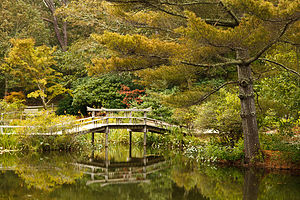 Mytoi Garden Arched Wooden BridgeIn addition to the garden paths, the ½-mile Salt Marsh trail, located across the street from the Mytoi parking lot, takes visitors through a pitch pine forest and along the salt marshes of Poucha Pond.
Mytoi Garden Arched Wooden BridgeIn addition to the garden paths, the ½-mile Salt Marsh trail, located across the street from the Mytoi parking lot, takes visitors through a pitch pine forest and along the salt marshes of Poucha Pond.
0.2 miles further down Dike Road is the infamous Dike Bridge, where in 1969 Teddy Kennedy lost all chances of becoming president when his car drove off the bridge, resulting in the death of Mary Jo Kopechne. For many years afterwards, the bridge was closed to all vehicles, but has long since reopened, allowing four-wheel drive vehicles to access the beach. This bridge was another stop on our wedding photo tour.
Poucha Pond lies to the right (south) of the bridge, and Cape Poge Bay to the north. It is a great spot for kayaking, and fortunately, we had brought t he boys’ kayaks and our canoe along this year. TheTTOR rents canoes and kayaks if you don’t have your own.
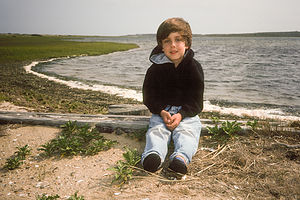 Andrew by Poucha PondCape Poge Bay is a bit larger (2.5 miles long) and more open, so we decided that the more sheltered Poucha Pond would be a better choice for novice paddlers such as ourselves. We had a lot of fun spending the afternoon exploring the pond and weaving in and out of the salt marsh. When we were finished, we had the boys haul their kayaks up onto the sand near the bridge. Andrew, however, left his a bit too much in the water and before we knew it, it had floated off the sand and out into Cape Poge Bay. Herb, who was putting the canoe on top of the Suburban at the time, feigned ignorance of what was going on, leaving it up to me to swim out after the loose kayak. I gave it back to Andrew who proceeded to repeat his half-ass job of kayak beach placement, forcing me to repeat my swim out into the Bay. Needless to say, I was aggravated with two out of the three Gaidus men. If Tommy didn’t stop laughing it would be three.
Andrew by Poucha PondCape Poge Bay is a bit larger (2.5 miles long) and more open, so we decided that the more sheltered Poucha Pond would be a better choice for novice paddlers such as ourselves. We had a lot of fun spending the afternoon exploring the pond and weaving in and out of the salt marsh. When we were finished, we had the boys haul their kayaks up onto the sand near the bridge. Andrew, however, left his a bit too much in the water and before we knew it, it had floated off the sand and out into Cape Poge Bay. Herb, who was putting the canoe on top of the Suburban at the time, feigned ignorance of what was going on, leaving it up to me to swim out after the loose kayak. I gave it back to Andrew who proceeded to repeat his half-ass job of kayak beach placement, forcing me to repeat my swim out into the Bay. Needless to say, I was aggravated with two out of the three Gaidus men. If Tommy didn’t stop laughing it would be three.
On the other side of the Dike Bridge is East Beach, a secluded barrier beach that is part of the Cape Poge Wildlife Refuge, managed by TTOR. At the time of this writing, admission for walkovers to the beach was $3 for adults and free for children under 15. We have come to this beach many, many times over the past three decades. The currents here are not as strong as those at Wasque Point, so it is a better place to swim.
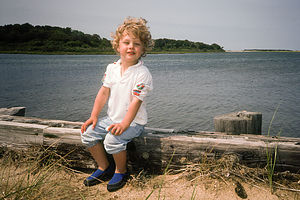 Tommy by Poucha PondAlthough Wasque is generally considered to be the best fishing spot on Chappy, Herb and I had our most prolific fishing day ever on East Beach. Way back in 1984, before we were even married, Herb and I came to Martha’s Vineyard for Columbus Day Weekend. The main draw for Herb, I am sorry to say, was not the romance of a cozy Victorian inn, but rather the incredible fishing that occurs on this island during the fall months. In fact, the Martha’s Vineyard Striped Bass and Bluefish Derby is held each year from mid-September through mid-October, a time when grown men become obsessed with the act of catching the “Big One”.
Tommy by Poucha PondAlthough Wasque is generally considered to be the best fishing spot on Chappy, Herb and I had our most prolific fishing day ever on East Beach. Way back in 1984, before we were even married, Herb and I came to Martha’s Vineyard for Columbus Day Weekend. The main draw for Herb, I am sorry to say, was not the romance of a cozy Victorian inn, but rather the incredible fishing that occurs on this island during the fall months. In fact, the Martha’s Vineyard Striped Bass and Bluefish Derby is held each year from mid-September through mid-October, a time when grown men become obsessed with the act of catching the “Big One”.
Well anyway, on this one particular day, Herb and I had set up shop on East Beach. We generally do not fish with bait, so rather than casting out and waiting for something to bite, ours is a much more active process where we continuously cast out a lure and slowly reel it in trying to tempt a poor unsuspecting fish. This can get tiring and boring after awhile if nothing is happening, so often we get lazy and just wait and see if anyone else is catching anything. Well, on this particular day, we were the only ones fishing on East Beach, so we had no one to do the dirty work for us.
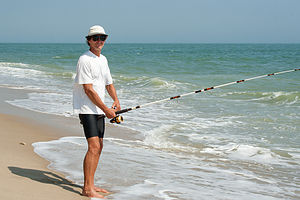 Herb Surf Fishing at Wasque - LEGAfter not too much wait, Herb pulled in the first blue—a nice, feisty 3 or 4 pounder. Blues put up a terrific fight and are really a lot of fun to catch. That got my attention, so I started casting too. Soon we were hauling them in one after the other. Before we knew it, we had over 50 bluefish lined up on the shore, more than half of which I would have to claim as mine. We were starting to attract quite a bit of attention from passersby.
Herb Surf Fishing at Wasque - LEGAfter not too much wait, Herb pulled in the first blue—a nice, feisty 3 or 4 pounder. Blues put up a terrific fight and are really a lot of fun to catch. That got my attention, so I started casting too. Soon we were hauling them in one after the other. Before we knew it, we had over 50 bluefish lined up on the shore, more than half of which I would have to claim as mine. We were starting to attract quite a bit of attention from passersby.
I am not sure what possessed us to keep them all. My arms were already tired from hauling them in, and now we had to scale and fillet them. I was given the job of scaling as Herb usually assigns me the unskilled tasks. By the time I got to my 50th fish, my hands were bent like claws, set in place from holding the scaler too long. Now the question, which we should have asked ourselves hours ago, came to mind—What were we going to do with 50 fillets in our cozy little room at the Kelley House? And I don’t even like bluefish. Well, the answer was a large cooler and many, many trips to the ice machine. We managed to keep them cool and they traveled home with us on the Ferry. Herb’s rock climbing buddy Ed smoked them and they used them as snacks on their climbing trips—Yuck!!!
 Tommy inside Bait BucketUsually, though when we want to fish, we head to Wasque Point, also part of the Cape Poge Wildlife Refuge and about a mile and a half south of East Beach. Wasque is so popular for fishing because of the Rip, a really strong current and undertow that is very dangerous for swimming, but very popular with stripers and blues. On any given day, but especially during the Derby, there are always dozens of four-wheel drives lined up along the water’s edge.
Tommy inside Bait BucketUsually, though when we want to fish, we head to Wasque Point, also part of the Cape Poge Wildlife Refuge and about a mile and a half south of East Beach. Wasque is so popular for fishing because of the Rip, a really strong current and undertow that is very dangerous for swimming, but very popular with stripers and blues. On any given day, but especially during the Derby, there are always dozens of four-wheel drives lined up along the water’s edge.
If you are fortunate enough to have a four-wheel drive vehicle and an annual pass, Wasque Point is a short, bumpy ride along the beach. However, those on two wheels must retrace their steps from East Beach back along the dirt Dike Road out to the paved Chappaquiddick Road. From there, make a left and follow Chappaquiddick Road for 0.8 miles to the junction with Wasque Road. Wasque Road is paved for about a half mile before turning into a stony, rutted sandy road. This sandy road goes on for about 1 mile before coming to the entrance to Wasque Reservation. I remember trying to peddle over this sandy road with a 2-year-old Tommy in a child seat on the back of my road bike. I didn’t even have a mountain bike at that time. I had to be nuts.
Right past the entrance there is a lovely trail to the left that leads through a pine forest and down to Pocha Pond. I have often left the beach when the fishing is slow to come here for a run.
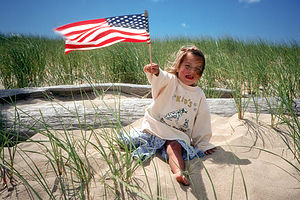 Madison waving US Flag at ChappyThe sandy road continues a short distance further before ending in a parking lot. Right next to the outhouse is a rack to lock your bikes before heading down to the beach. A short distance from the bike rack is a bluff overlooking the beach where you get your first glimpse of four-wheel drives lined up ready to catch the big one. Until recently, there was also a lovely small pond situated between the bluff and the beach, appropriately named Swan Pond due to its resident Swan who was often found leisurely floating along its surface.
Madison waving US Flag at ChappyThe sandy road continues a short distance further before ending in a parking lot. Right next to the outhouse is a rack to lock your bikes before heading down to the beach. A short distance from the bike rack is a bluff overlooking the beach where you get your first glimpse of four-wheel drives lined up ready to catch the big one. Until recently, there was also a lovely small pond situated between the bluff and the beach, appropriately named Swan Pond due to its resident Swan who was often found leisurely floating along its surface.
I have always found this spot peaceful and comforting, so much so, that when I was going through a particularly rough time I chose it as my “happy place.” About 20 years back when I was undergoing chemotherapy for breast cancer, I was encouraged to relax and visualize a place where I felt safe and happy. Although I have been to some pretty spectacular places, this tranquil pond surrounded by tall reeds swaying in the breeze is what kept popping into my mind—and it stayed there for years whenever I needed a comforting place to hide.
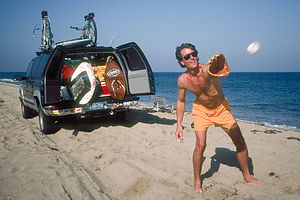 Herb playing catch on beachYou can imagine my reaction when we came here after Hurricane Irene struck in 2011 to find that the pond had been wiped out by the storm and completely filled in with sand. My sanctuary was now just part of the Wasque beach front. My first reaction was a rather self-centered one—“What does this mean for me? Is it some kind of ominous sign?” But then I realized that maybe I just didn’t need it anymore. Then I got sad for the swan.
Herb playing catch on beachYou can imagine my reaction when we came here after Hurricane Irene struck in 2011 to find that the pond had been wiped out by the storm and completely filled in with sand. My sanctuary was now just part of the Wasque beach front. My first reaction was a rather self-centered one—“What does this mean for me? Is it some kind of ominous sign?” But then I realized that maybe I just didn’t need it anymore. Then I got sad for the swan.
The wooden staircase and the walkway to the beach had also taken a hit from the storm and was quite torn up. The beach looked entirely different, a reminder of the power of Mother Nature and its constant impact on this island. Just a few years back, in 2007, another storm breached the beach around the bend from Wasque, separating Chappy from the rest of Martha’s Vineyard once again. It was strange to think of how so many times over the past years we had driven our Suburban from South Beach in Edgartown to Wasque and how that was nowimpossible—at least until Mother Nature continued its work and filled the gap in with sand again.
I have so many fond memories of days spent at Wasque that I sure hope this place recovers from the devastation of the storm.
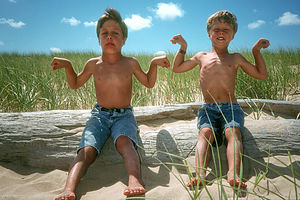 Boys Flexing on "Herb + Lolo" LogIronically, this fishing hot spot is also the site of one of Herb’s more romantic acts on the island. For many years a large log, which had been washed ashore, sat at the edge of where the dune grass meets the beach. When the kids were little, they used to climb up on its tall end and leap off into the sand. As years went by, more and more carvings appeared on the log as people continued to etch their initials into the wood. With a bit of pressure from myself and the kids, Herb sacrificed a few valuable fishing hours one afternoon, laboriously carving “Herb + Lolo” inside a heart with his Swiss Army knife. Years later, my brother was shamed into doing the same for him and his wife. He isn’t quite as handy with a knife, so his was a much greater and longer “labor” of love. It was nice to come here year after year and have that log looking over us.
Boys Flexing on "Herb + Lolo" LogIronically, this fishing hot spot is also the site of one of Herb’s more romantic acts on the island. For many years a large log, which had been washed ashore, sat at the edge of where the dune grass meets the beach. When the kids were little, they used to climb up on its tall end and leap off into the sand. As years went by, more and more carvings appeared on the log as people continued to etch their initials into the wood. With a bit of pressure from myself and the kids, Herb sacrificed a few valuable fishing hours one afternoon, laboriously carving “Herb + Lolo” inside a heart with his Swiss Army knife. Years later, my brother was shamed into doing the same for him and his wife. He isn’t quite as handy with a knife, so his was a much greater and longer “labor” of love. It was nice to come here year after year and have that log looking over us.
However, a storm even earlier than Irene washed that log out to sea. Hmm…I wonder what that could possibly mean?
Description
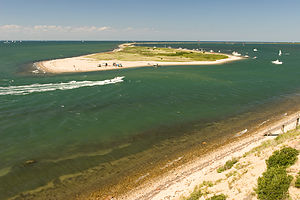 Gut View from the Rental House on the BluffChappaquiddick is a small island (sometimes) a stone’s throw away from Edgartown. The reason I say sometimes is that for years a sand spit has connect South Beach in Katama to Chappaquiddick but severe storms in 2007 breached the thin, south-facing Norton Point making it an island once again. In fact, the name Chappaquiddick comes from an Indian word "cheppiaquidne" meaning "separated island." It is technically a part of Edgartown, but I felt that it was unique and distinct enough to be given a separate description.
Gut View from the Rental House on the BluffChappaquiddick is a small island (sometimes) a stone’s throw away from Edgartown. The reason I say sometimes is that for years a sand spit has connect South Beach in Katama to Chappaquiddick but severe storms in 2007 breached the thin, south-facing Norton Point making it an island once again. In fact, the name Chappaquiddick comes from an Indian word "cheppiaquidne" meaning "separated island." It is technically a part of Edgartown, but I felt that it was unique and distinct enough to be given a separate description.
The On Time Ferry runs every 5 minutes during the summer, bringing passengers back and forth between Edgartown and Chappy. For a schedule and fees, see: http://www.chappyferry.net/. There is a lovely, little beach located besides the ferry landing that offers a small sandy beach, calm waters, and great views of the Edgartown Lighthouse as well as the hustle and bustle of boats coming into and out of the harbor.
Once you get off the ferry, there is only one road to take, Chappaquiddick Road, and it also happens to be the only paved road on the island.
About 1.3 miles from the ferry, on the left, is North Neck Road, a dirt road leading 1.1 miles out to the trailhead for the North Neck Highlands Preserve, a property of the Martha’s Vineyard Land Bank. The trail leads to a tremendous view from the highlands out over Cape Poge Bay and “the Gut,” an area very popular for fishing, as well as windsurfing and kiteboarding. The only way back from this point, is to retrace your steps back to Chappaquiddick Road.
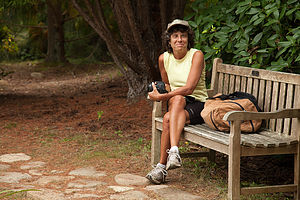 Lolo on Mytoi Garden BenchOnce back out on Chappaquiddick Road, another 0.3 miles (1.6 miles from the ferry) brings you to the Brine’s Pond Preserve, a Martha’s Vineyard Land Bank property, located on the right side of the road, just past the Chappaquiddick Community Center. During the 1700 and 1800s, this area was mostly grassland and used as pasture for sheep and cattle. When the livelihoods of the settlers shifted to whaling, the ungrazed land allowed for the growth of blueberry, bayberry and huckleberry bushes as well as red cedar trees and oaks. The most notable feature of the Preserve, however, is an island of beetlebung (tupelo) trees in the center of a small pond. A hiking trail encircles the pond. Early settlers used the dense wood from these trees to make wooden mallets, called “beetles,” which drove the corks, called “bungs,” that plugged barrel holes.
Lolo on Mytoi Garden BenchOnce back out on Chappaquiddick Road, another 0.3 miles (1.6 miles from the ferry) brings you to the Brine’s Pond Preserve, a Martha’s Vineyard Land Bank property, located on the right side of the road, just past the Chappaquiddick Community Center. During the 1700 and 1800s, this area was mostly grassland and used as pasture for sheep and cattle. When the livelihoods of the settlers shifted to whaling, the ungrazed land allowed for the growth of blueberry, bayberry and huckleberry bushes as well as red cedar trees and oaks. The most notable feature of the Preserve, however, is an island of beetlebung (tupelo) trees in the center of a small pond. A hiking trail encircles the pond. Early settlers used the dense wood from these trees to make wooden mallets, called “beetles,” which drove the corks, called “bungs,” that plugged barrel holes.
Continuing along the paved Chappaquiddick Road, in 0.6 miles (2.2 miles from the ferry) is the Chappy General Store, the only store on the island. In another .3 miles (2.5 from ferry), the road takes a sharp bend to the right. The unpaved Dike Road goes straight.
A half mile down the sandy Dike Road is Mytoi, a 14-acre secluded Japanese-style garden. Sheltered by a lovely pine grove, the preserve features both native and non-native flowers and plants, including Japanese maple trees, dwarf white pine, Japanese cedar, birch, and golden bamboo. Winding footpaths lead through the gardens to its focal point – an arched wooden bridge to a small island in a pond, where you are sure to spot turtles, goldfish, and frogs. A visit to Mytoi Gardens is a serene and contemplative respite from the hustle and bustle of summer activity on Martha’s Vineyard. Mytoi is a property of The Trustees of Reservations (TTOR), a non-profit, land conservation and historic preservation organization in Massachusetts. Entrance to the garden is free. In addition to the garden paths, the ½-mile Salt Marsh trail, located across the street from the Mytoi parking lot, takes visitors through a pitch pine forest and along the salt marshes of Poucha Pond.
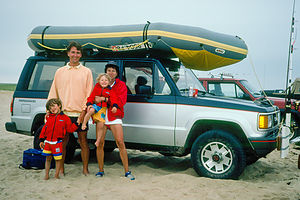 Family on beach with Isuzu Trooper and Avon Redshank0.2 miles further down Dike Road is the infamous Dike Bridge, where in 1969 Mary Jo Kopechne died when Senator Teddy Kennedy’s car drove off the bridge.
Family on beach with Isuzu Trooper and Avon Redshank0.2 miles further down Dike Road is the infamous Dike Bridge, where in 1969 Mary Jo Kopechne died when Senator Teddy Kennedy’s car drove off the bridge.
Poucha Pond lies to the right (south) of the bridge, and Cape Poge Bay to the north – both of which are very popular with kayakers. The TTOR offers naturalist-led tours as well as canoe and kayak rentals. Poucha Pond is smaller, shallower, and more sheltered, and therefore better for less experienced paddlers. One can either paddle in the open pond or weave in and out of the salt marsh. Cape Poge Bay is a bit larger – 2.5 miles long and 1.2 miles wide – and more open, but well worth the extra effort to reach the Cape Poge Gut.
On the other side of the Dike Bridge is East Beach, a secluded barrier beach, managed by The Trustees of Reservations. East Beach is part of the Cape Poge Wildlife Refuge, which extends seven miles from Wasque Point on the south, past the Cape Poge Lighthouse, to Cape Poge Gut. This beach is very popular with swimmers and fishermen. At the time of this writing, admission for walkovers to the beach is $3 for adults and free for children under 15. Annual over-sand vehicle permits are $80 for TTOR members and $200 for non-member, non-island residents.
Approximately a mile and a half south of East Beach is Wasque Point, also managed by The Trustees of Reservations. If traveling by over-sand vehicle, it is a short, bumpy ride along the beach. However, bicyclists must retrace their steps back along the dirt Dike Road out to the paved Chappaquiddick Road. Make a left and follow Chappaquiddick Road for 0.8 miles to the junction with Wasque Road. Wasque Road is paved for about a half mile before turning into a stony, rutted sandy road. Continue on this sandy road for about 1 mile to the entrance to Wasque Reservation. Admission during the summer is the same as that for East Beach.
The actual point, known as the Rip because of its strong undertow, is very dangerous for swimmers, but a great place for fishermen in search of striped bass and bluefish. On almost any day, dozens of four-wheel drive vehicles line the water’s edge, especially during the annual Striped Bass and Bluefish Derby held each year for several weeks in September and October. Wasque is also a great spot for birdwatching. Sandpipers, seagulls, and ospreys hover over the beach, while great blue herons, egrets, and other migrating shorebirds frequent nearby Poucha Pond.
Wasque Point is the end of the road, or at least until Mother Nature decides it’s time to close the gap between here and Norton Point again. The only way back is to retrace one steps back to the Chappy Ferry.
There is one very long public beach on Chappaquiddick:
- East Beach - part of the Cape Poge Wildlife Refuge, which extends seven miles from Wasque Point on the south, past the Cape Poge Lighthouse, to Cape Poge Gut
- Lighthouse Beach – located near the Edgartown lighthouse on Edgartown Harbor
Kayaking opportunities:
- Poucha Pond
- Cape Poge Bay
Edgartown
Thursday, July 3, 2008 - 11:00am by Lolo0 miles and 0 hours from our last stop - 1 night stay
Travelogue
 Edgartown Lighthouse at DuskIt’s funny how such a small island can have such a variety of distinctive histories - Aquinnah has it Native American roots, Oak Bluffs its religious revivalist meetings, Tisbury its commercial trade, and Edgartown its whaling. While centuries have passed, these beginnings are very much still a part of these island communities today, and as a result, each town has its own distinctive personality. I would have to say that Edgartown’s is classy and reserved, a bit better behaved than the more raucous Oak Bluffs, but not as reclusive as its more rural neighbors Up Island.
Edgartown Lighthouse at DuskIt’s funny how such a small island can have such a variety of distinctive histories - Aquinnah has it Native American roots, Oak Bluffs its religious revivalist meetings, Tisbury its commercial trade, and Edgartown its whaling. While centuries have passed, these beginnings are very much still a part of these island communities today, and as a result, each town has its own distinctive personality. I would have to say that Edgartown’s is classy and reserved, a bit better behaved than the more raucous Oak Bluffs, but not as reclusive as its more rural neighbors Up Island.
 Fishing on Memorial WharfLike Oak Bluffs, Edgartown’s early history was rooted in religion – but in a different way. Rather than a gathering place for established religious movements, as in Oak Bluffs, Edgartown was settled in 1642 for the purpose of converting the Wampanoag Indians on the island to Christianity. Fortunately, unlike many examples of disastrous cultural clashes in the history of European settlements in North America, the relationship between the English settlers, under the leadership of the Reverend Thomas Mayhew, Jr., and the Wampanoags of Martha’s Vineyard was a peaceful one, characterized by mutual respect. In fact, when Mayhew was lost at sea 15 years after he had come to the island, the Wampanoag were so filled with grief that they made sacred the spot where he had said his last farewell to them. As a sign of their grief and respect, each time they passed this spot, they would place a stone on a cairn as a tribute to him. In 1901, the large cairn of stones was replaced by a single boulder with a bronze plaque, and a token small pile of stones cemented to its back. It is now known as “The Place on the Wayside” and it can be found along the airport road between Edgartown and West Tisbury.
Fishing on Memorial WharfLike Oak Bluffs, Edgartown’s early history was rooted in religion – but in a different way. Rather than a gathering place for established religious movements, as in Oak Bluffs, Edgartown was settled in 1642 for the purpose of converting the Wampanoag Indians on the island to Christianity. Fortunately, unlike many examples of disastrous cultural clashes in the history of European settlements in North America, the relationship between the English settlers, under the leadership of the Reverend Thomas Mayhew, Jr., and the Wampanoags of Martha’s Vineyard was a peaceful one, characterized by mutual respect. In fact, when Mayhew was lost at sea 15 years after he had come to the island, the Wampanoag were so filled with grief that they made sacred the spot where he had said his last farewell to them. As a sign of their grief and respect, each time they passed this spot, they would place a stone on a cairn as a tribute to him. In 1901, the large cairn of stones was replaced by a single boulder with a bronze plaque, and a token small pile of stones cemented to its back. It is now known as “The Place on the Wayside” and it can be found along the airport road between Edgartown and West Tisbury.
 Edgartown Harbor at DuskI am embarrassed to say that after 30 years on the island, I have not seen this plaque, nor did I even know it existed until I began researching the history of Edgartown for this write-up. Once again, as with the story of “Boomer” in the State Forest, I have learned that research should happen before and not after travel to a place to get the most out of it.
Edgartown Harbor at DuskI am embarrassed to say that after 30 years on the island, I have not seen this plaque, nor did I even know it existed until I began researching the history of Edgartown for this write-up. Once again, as with the story of “Boomer” in the State Forest, I have learned that research should happen before and not after travel to a place to get the most out of it.
A more obvious remnant of Edgartown’s past is the role it played in the whaling boom of the 1800s. You can’t walk very far in Edgartown without passing one of its many stately Captain’s Houses – always painted in white with black shutters – with their wraparound porches and oftentimes widow’s walk atop the roof. For years when the boys were little, our stroll along North Water Street always included gazing up at a lone female figure (stuffed I think) peering through a telescope, out across the Great Harbor in search of her man. Sadly, she is no longer there – maybe her Captain finally came home or maybe she just gave up trying. Sorry to be a spoil sport, but the real purpose of these “widow walks” was to allow residents to pour sand down their chimneys in the event of a chimney fire—much less romantic than the thought of anxious wives longing for the return of their loved one.
 Night View from Memorial Wharf of Fishing BoatsI would have to say that one of the things I enjoy most about Martha’s Vineyard is just strolling along the narrow streets of Edgartown, enjoying its unique history, charm, and beauty. In addition to the fine views of the great harbor and lighthouse, there are dozens of elegant shops, art galleries, and restaurants to wile away a summer day – or better yet, a summer evening, the time of day that we generally like to come to town.
Night View from Memorial Wharf of Fishing BoatsI would have to say that one of the things I enjoy most about Martha’s Vineyard is just strolling along the narrow streets of Edgartown, enjoying its unique history, charm, and beauty. In addition to the fine views of the great harbor and lighthouse, there are dozens of elegant shops, art galleries, and restaurants to wile away a summer day – or better yet, a summer evening, the time of day that we generally like to come to town.
After an active day of beaching, fishing, or biking at one of the many prime locations around the island, we usually park the RV in the big lot by the Triangle and walk or bike the mile into town. We like this time of day because the lighting that occurs just before and right after sunset is really good for photography, another one of our favorite island pastimes.
 Andrew on Memorial Wharf DeckWe often start atop Memorial Wharf, where we can look out over the harbor and watch the boats return from a day of fishing – some for fun, and others to make a living. From here, one can watch the ever-faithful and ever-running On-Time Ferry, as it makes its way back and forth across the short distance to Chappaquiddick. When you get tired of looking out at the harbor, which is hard to do, you can just turn around and look out over the quaint and picturesque houses and shops of Edgartown. There is no bad direction to look.
Andrew on Memorial Wharf DeckWe often start atop Memorial Wharf, where we can look out over the harbor and watch the boats return from a day of fishing – some for fun, and others to make a living. From here, one can watch the ever-faithful and ever-running On-Time Ferry, as it makes its way back and forth across the short distance to Chappaquiddick. When you get tired of looking out at the harbor, which is hard to do, you can just turn around and look out over the quaint and picturesque houses and shops of Edgartown. There is no bad direction to look.
Once we are done with the photography, and can afford to have sticky fingers, we head to one of Edgartown’s many ice cream shops to get a cone to accompany us on our walk through town. You need a couple of nights in Edgartown so that you can experience each of the three great ice cream establishments: Candy Bazaar, Scoops, and Mad Martha’s.
 Edgartown Lighthouse from BeachOne of our favorite evening walks is to the Edgartown Lighthouse, which stands at the entrance to Edgartown Harbor and Katama Bay. The narrow path to get to it is located across from the Harbor View Hotel on North Water Street. There are no lights, so it is generally quite dark, and often a good place to immaturely scare your loved ones, which we have done on many occasions. My brother Jim had the misfortune of hiding in the bushes and jumping out on a group of strangers my mistake. They were not amused.
Edgartown Lighthouse from BeachOne of our favorite evening walks is to the Edgartown Lighthouse, which stands at the entrance to Edgartown Harbor and Katama Bay. The narrow path to get to it is located across from the Harbor View Hotel on North Water Street. There are no lights, so it is generally quite dark, and often a good place to immaturely scare your loved ones, which we have done on many occasions. My brother Jim had the misfortune of hiding in the bushes and jumping out on a group of strangers my mistake. They were not amused.
The original lighthouse was on a man-made granite island connected to the mainland by a wooden walkway, called the “Bridge of Sighs,” because it was often the place where men going off to sea on years-long whaling voyages parted with their families. Eventually the strong currents created a small barrier beach and sandy access strip that made the walkway unnecessary. The original lighthouse was destroyed by the Hurricane of 1938. In the following year, the white, cast-iron Essex Light in Ipswich, Massachusetts, was relocated to Edgartown to replace the one destroyed by the storm.
 Boys on South BeachThe area around the lighthouse is called Lighthouse Beach, and it is a great place to come on a sunny day to just relax. It’s not as good for swimming as many of the other beaches on the island, but the views are hard to beat. You can just sit back and view the hustle and bustle of boats entering and leaving the harbor, the On-Time Ferry shuttling back and forth between Edgartown and Chappaquiddick, the captains’ houses along the Edgartown shoreline, the Chappy Beach Club, and “The Gut” at the tip of the Cape Poge Wildlife Refuge.
Boys on South BeachThe area around the lighthouse is called Lighthouse Beach, and it is a great place to come on a sunny day to just relax. It’s not as good for swimming as many of the other beaches on the island, but the views are hard to beat. You can just sit back and view the hustle and bustle of boats entering and leaving the harbor, the On-Time Ferry shuttling back and forth between Edgartown and Chappaquiddick, the captains’ houses along the Edgartown shoreline, the Chappy Beach Club, and “The Gut” at the tip of the Cape Poge Wildlife Refuge.
Although we usually have spent our time on the island in the RV or in a rental house, we have on occasion stayed at the Edgartown Inn, a wonderfully quaint and cozy inn on North Water Street with the most hospitable staff you ever want to meet. This Inn holds a very special place in our hearts because it is the site of two very important firsts for us. It was the place that we stayed on our very first trip to the island in 1980, and it was the place that we stayed on the first night of our honeymoon in 1985.
 Lolo and Herb's Wedding at Federated ChurchThat brings me to the wedding. Herb and I loved the Vineyard so much that we thought it very appropriate that we begin our life-long journey together there – not to mention the fact that Herb realized the Striped Bass and Bluefish Derby would be going on the same time – ahh, romance.
Lolo and Herb's Wedding at Federated ChurchThat brings me to the wedding. Herb and I loved the Vineyard so much that we thought it very appropriate that we begin our life-long journey together there – not to mention the fact that Herb realized the Striped Bass and Bluefish Derby would be going on the same time – ahh, romance.
The planning, even though most of it was done remotely, was quite easy. This was way before Martha’s Vineyard became “the” place to get married.” Nowadays, I am sure a Vineyard wedding requires years of planning, not the handful of phone calls I made (church, restaurant, florist, and band) that I did a few months in advance.
 Lolo the BrideHowever, no amount of planning can thwart the intentions of Mother Nature. As our wedding day (September 28) approached, we anxiously watched the Weather Channel track Hurricane Gloria’s progress up the East coast. Gloria was forecast to hit the island on Friday, the 27th. Knowing that there was a very strong possibility that the ferries would stop running, we made a quick decision. Herb and I, my parents, and Herb’s parents quickly threw our stuff together (including wedding gown) and started driving to Woods Hole Wednesday afternoon, fully knowing that the six of us might be the only attendees at the wedding. We literally caught the last ferry going over to the island that night – all ferries would possibly be canceled the next two days. The wind was already fiercely howling as we stepped out onto the deck. Hopefully, we were not making a foolish decision. But you have to keep in mind that Herb had struggled a bit with the “commitment” concept – we had already been dating 11 years – so I was not about to let a little Hurricane give him a way out.
Lolo the BrideHowever, no amount of planning can thwart the intentions of Mother Nature. As our wedding day (September 28) approached, we anxiously watched the Weather Channel track Hurricane Gloria’s progress up the East coast. Gloria was forecast to hit the island on Friday, the 27th. Knowing that there was a very strong possibility that the ferries would stop running, we made a quick decision. Herb and I, my parents, and Herb’s parents quickly threw our stuff together (including wedding gown) and started driving to Woods Hole Wednesday afternoon, fully knowing that the six of us might be the only attendees at the wedding. We literally caught the last ferry going over to the island that night – all ferries would possibly be canceled the next two days. The wind was already fiercely howling as we stepped out onto the deck. Hopefully, we were not making a foolish decision. But you have to keep in mind that Herb had struggled a bit with the “commitment” concept – we had already been dating 11 years – so I was not about to let a little Hurricane give him a way out.
The next day we went to the Navigator Restaurant in Edgartown to discuss the final plans for the reception, where we were told to come back the next morning if they were still standing. That was comforting. Workmen were boarding up the windows as we left. Okay, this was definitely going to be different than planned. Ironically, I actually found myself a lot less nervous about being a bride. Things were now totally out of our control.
 Lolo and Sons with Jim and Alex at South BeachWe went back to the condo we rented in the center of the island to weather out the storm. The wind howled all night and the rain came down, but the island was spared from any real damage – just a few trees down, but everything still standing. And an added bonus – the days following a hurricane are truly beautiful, as it seems to clear out everything and leave crystal clear blue skies behind.
Lolo and Sons with Jim and Alex at South BeachWe went back to the condo we rented in the center of the island to weather out the storm. The wind howled all night and the rain came down, but the island was spared from any real damage – just a few trees down, but everything still standing. And an added bonus – the days following a hurricane are truly beautiful, as it seems to clear out everything and leave crystal clear blue skies behind.
Gloria wasn’t without its problems though and I give thanks and credit to our brave and determined friends, who had a difficult journey up I95 trying to find gas stations with power to pump gas. All but two of our guests made it to the wedding in time.
The wedding, if I must say so myself, was beautiful. The church service was held at the Federated Church on South Summer Street – a beautiful old whaling church with boxed pews and two aisles. I got to pick which one I walked down. The reception was held at the Navigator Restaurant at the end of Main Street, overlooking the harbor and the check-in point for the Bluefish Derby. Herb spent a good deal of the reception gazing down from the balcony at the fisherman bringing in their catch to be weighed. There was a beautiful Harvest Moon that night rising over the harbor. I would have to say that Gloria, who fortunately left early and did not attend the wedding, made the mood even more festive and celebratory.
 Tommy with first 100 bicycle mile Vineyard VacationOne other thing about holding a wedding in a beautiful place – you can’t get rid of your friends for the honeymoon, but that’s okay. Ours was spent with 11 of our closest friends, one of which got quite annoyed when her husband announced that this was the best honeymoon he had ever been on.
Tommy with first 100 bicycle mile Vineyard VacationOne other thing about holding a wedding in a beautiful place – you can’t get rid of your friends for the honeymoon, but that’s okay. Ours was spent with 11 of our closest friends, one of which got quite annoyed when her husband announced that this was the best honeymoon he had ever been on.
After our wedding, and right up until the time we bought the RV in 1999, each summer we rented a house for 2 weeks with my brother and his wife and other assorted friends – generally out by Katama (South Beach). Probably our favorite house, which we rented for about 7 years, was located on Katama Farm Road, adjacent to what was then Katama Farm (today it is the Farm Institute).
The island is actually very lucky to still have this huge piece of very prime real estate undeveloped. It almost wasn’t so. In the 70s, the farm was purchased by the Strock family, who planned to divide it into 700 buildable lots. Thankfully, Strock Enterprises went bankrupt and the development never took place. Eventually, conservation groups banded together to raise awareness and funds, resulting in the property being purchased by the town of Edgartown.
From the 1980s – 2005, the farm was leased to various tenant farmers, who attempted to make a profitable dairy farm. These were the years that we took the boys to see the cows and the pigs. Unfortunately, none of these farmers were able to make a go of it, and the farm became vacant and fell into disrepair. Fortunately, the farm is now run by the FARM Institute (TFI), who has lovingly restored barns, fields, and equipment.
 Boys on Farmland outside Tony's Rental HouseThe house at the edge of the farm, we affectionately called “Tony’s House,” because Tony was the gentleman that rented it to us each year, at what we later found out was a very good price. From there, we could walk to South Beach, although we generally drove because of too much beach paraphernalia. South Beach is probably the nicest public beach on the island for pure fun in the surf. Unlike the calm waters on the northern shore of the island, the waves here can be very fun. It does, however, get pretty crowded on a hot summer day.
Boys on Farmland outside Tony's Rental HouseThe house at the edge of the farm, we affectionately called “Tony’s House,” because Tony was the gentleman that rented it to us each year, at what we later found out was a very good price. From there, we could walk to South Beach, although we generally drove because of too much beach paraphernalia. South Beach is probably the nicest public beach on the island for pure fun in the surf. Unlike the calm waters on the northern shore of the island, the waves here can be very fun. It does, however, get pretty crowded on a hot summer day.
Near the end of Katama Road, is the Edgartown Bay Road, where we also rented a house for several years. The views of Katama Bay along this road are very pretty. Over the years, we have used the scenic 2-mile loop as a place to run, bike, and even roller blade.
Along the Edgartown Bay Road is Town Launch, a public boat launch on Katama Bay, from which we have on many occasions launched a variety of watercraft – my brother’s Boston Whaler, our faithful blow-up boat, a windsurfer, and kayaks. From this point, you can cruise along Katama Bay, past some very beautiful homes, and into Edgartown Harbor, past the Chappy Ferry and onto the lighthouse. It’s one of my favorite cruises.
 Herb loading Kayaks at Norton PointAs I mentioned in the Chappy write-up, 2012 was the first year that we had our new kayaks on the island, and we quickly found that it was really a great way to see new places or at least old places in a new way. We decided to launch our kayaks at Town Launch and paddle across Katama Bay to Norton Point to explore the breach that a 2007 storm made in the barrier beach that used to connect Edgartown to Chappy. The wave action in the opening between the bay and the ocean was definitely a bit intimidating – kind of like a washing machine – so we decided to stop just short of it and beach the kayaks and just lounge in the sun for awhile. There were some pretty strong currents, which we managed to ride a bit back into the main part of Katama Bay. It was a good maiden voyage for our kayaks – about 5 or 6 miles round trip, highly scenic, and not too strenuous. Probably the most strenuous part of the event was getting the kayaks back up onto the racks on top of the RV. I don’t know how Herb does it.
Herb loading Kayaks at Norton PointAs I mentioned in the Chappy write-up, 2012 was the first year that we had our new kayaks on the island, and we quickly found that it was really a great way to see new places or at least old places in a new way. We decided to launch our kayaks at Town Launch and paddle across Katama Bay to Norton Point to explore the breach that a 2007 storm made in the barrier beach that used to connect Edgartown to Chappy. The wave action in the opening between the bay and the ocean was definitely a bit intimidating – kind of like a washing machine – so we decided to stop just short of it and beach the kayaks and just lounge in the sun for awhile. There were some pretty strong currents, which we managed to ride a bit back into the main part of Katama Bay. It was a good maiden voyage for our kayaks – about 5 or 6 miles round trip, highly scenic, and not too strenuous. Probably the most strenuous part of the event was getting the kayaks back up onto the racks on top of the RV. I don’t know how Herb does it.
 Family on Grady cruising Edgartown HarborDuring the years that we rented houses on the island, we often trailered our 20-foot Grady White to the island and kept it in a marina. The years we kept it at the Harborside Marina were fun, because we got to hang out at their pool and hot tub. We took so many wonderful expeditions on that boat: two circumnavigations of the island, numerous trips to Menemsha Pond and Lake Tashmoo, fishing trips out to “The Gut” and Wasque, and the lovely evening cocktail cruises around Katama Bay and Edgartown Harbor.
Family on Grady cruising Edgartown HarborDuring the years that we rented houses on the island, we often trailered our 20-foot Grady White to the island and kept it in a marina. The years we kept it at the Harborside Marina were fun, because we got to hang out at their pool and hot tub. We took so many wonderful expeditions on that boat: two circumnavigations of the island, numerous trips to Menemsha Pond and Lake Tashmoo, fishing trips out to “The Gut” and Wasque, and the lovely evening cocktail cruises around Katama Bay and Edgartown Harbor.
Our Katama houses were a perfect bike riding distance to town for the boys when they were growing up, and I can’t think of how many times we rode those 3 miles along the bike path with the promise of “Mrs. Miller’s muffins” or “ice cream” at the other end.
 Family and Aggy at Edgartown Inn BreakfastOne of our favorite destinations was to have a classic Vineyard breakfast at the Edgartown Inn, where Herb and I spent our first honeymoon night and where my parents often stayed on their trips to the Vineyard. The best part of that breakfast for the boys was Henry, the waiter, who wore a bow tie and had plenty of tricks up his sleeve to entertain kids of all ages. Their personal favorite, which they never tired of, was the mustard trick. Henry would ask them if they wanted mustard – I am not sure why anyone would for breakfast. No matter how you answered, Henry would squeeze the bottle and mustard-colored yarn would shoot out dangerously close to your face. Henry was an icon at the Edgartown Inn up until the time he passed away a few years back.
Family and Aggy at Edgartown Inn BreakfastOne of our favorite destinations was to have a classic Vineyard breakfast at the Edgartown Inn, where Herb and I spent our first honeymoon night and where my parents often stayed on their trips to the Vineyard. The best part of that breakfast for the boys was Henry, the waiter, who wore a bow tie and had plenty of tricks up his sleeve to entertain kids of all ages. Their personal favorite, which they never tired of, was the mustard trick. Henry would ask them if they wanted mustard – I am not sure why anyone would for breakfast. No matter how you answered, Henry would squeeze the bottle and mustard-colored yarn would shoot out dangerously close to your face. Henry was an icon at the Edgartown Inn up until the time he passed away a few years back.
Our bicycle trips to town often did not end in Edgartown. Charged up on food, we would ride our bikes onto the Chappy Ferry and peddle out to Dike Bridge or Wasque (see Chappaquiddick) – a pretty impressive distance for kids on heavy Toys R Us bikes. There were many vacations where they would put as much as 100 miles on their odometers.
 Herb with Boat Caught Striped BassAnother great bike ride that we have often enjoyed is the route from Edgartown, out past Cannonball Park and the Triangle, and onto the bike path along State Beach. The ride here is very pretty, with Sengekontacket Pond on one side and Nantucket Sound on the other. On summer days, the entire 2-mile strip is lined with cars parked bumper to bumper mostly with families to enjoy the calm waters of State Beach. There are two bridges along this road going over inlets connecting the Sound to the Pond. From one of these bridges, you will find dozens of kids of all ages perched atop the rail and then jumping off into the inlet. For movie buffs, this inlet might be familiar as the site of a shark attack in the movie Jaws.
Herb with Boat Caught Striped BassAnother great bike ride that we have often enjoyed is the route from Edgartown, out past Cannonball Park and the Triangle, and onto the bike path along State Beach. The ride here is very pretty, with Sengekontacket Pond on one side and Nantucket Sound on the other. On summer days, the entire 2-mile strip is lined with cars parked bumper to bumper mostly with families to enjoy the calm waters of State Beach. There are two bridges along this road going over inlets connecting the Sound to the Pond. From one of these bridges, you will find dozens of kids of all ages perched atop the rail and then jumping off into the inlet. For movie buffs, this inlet might be familiar as the site of a shark attack in the movie Jaws.
Before the boys were in school, we usually came to the island in September or October, which was perfect – weather and water still warm, less crowds, and more fish. In fact, Fall is the best time of the year to catch blues and stripers, and timing of the annual Striped Bass and Bluefish Derby.
 4th of July on Edgartown Inn PorchHowever, once the boys started school, we had to time our vacations with the rest of the crowds and come during the height of summer. There were some advantages to this as well – one of which was joining in on the 4th of July celebrations in Edgartown. I am usually not that big a fan of parades, but the Edgartown one is a classic Americana event. Since my parents often stayed at the Edgartown Inn during the celebration, we got to join them on the porch – one of the best vantage points in town – not to mention the warm chocolate chip cookies that Sandy, the host of the Inn, made for her guests.
4th of July on Edgartown Inn PorchHowever, once the boys started school, we had to time our vacations with the rest of the crowds and come during the height of summer. There were some advantages to this as well – one of which was joining in on the 4th of July celebrations in Edgartown. I am usually not that big a fan of parades, but the Edgartown one is a classic Americana event. Since my parents often stayed at the Edgartown Inn during the celebration, we got to join them on the porch – one of the best vantage points in town – not to mention the warm chocolate chip cookies that Sandy, the host of the Inn, made for her guests.
There are the usual floats and marching bands, kilt-clad bagpipers, fire trucks, and veterans and flags as far as the eye can see. But this parade has one thing like no other – a giant inflatable rat, on par with Big Bird in the Macy’s Thanksgiving Day parade. Anyway, every year the same thing happens. Just as the rat inches its way past the cheering crowds on the Edgartown Inn porch, it gets caught in a low-hanging branch. This brings the entire parade to a halt. Then everyone cheers as the exterminator driving the float frantically tries to deflate it enough so that it can do a kind of limbo under the branch. It never gets old.
Neither does Edgartown. No matter how many times I come here, I will never tire of its charm.
Description
 Lolo on Porch of Edgartown Rental HouseThe town of Edgartown is located on the eastern end of Martha’s Vineyard (referred to as “down island”), bordered by Nantucket Sound to the northeast and east and the Atlantic Ocean to the south. The small island of Chappaquiddick, which is technically part of the town of Edgartown, is separated from the town by Edgartown Harbor and Katama Bay. Transportation between the two is via the On-Time Ferry, which carries three cars across the harbor approximately every 5 minutes. Chappaquiddick will be described in more detail in a separate stop.
Lolo on Porch of Edgartown Rental HouseThe town of Edgartown is located on the eastern end of Martha’s Vineyard (referred to as “down island”), bordered by Nantucket Sound to the northeast and east and the Atlantic Ocean to the south. The small island of Chappaquiddick, which is technically part of the town of Edgartown, is separated from the town by Edgartown Harbor and Katama Bay. Transportation between the two is via the On-Time Ferry, which carries three cars across the harbor approximately every 5 minutes. Chappaquiddick will be described in more detail in a separate stop.
Like Oak Bluffs, Edgartown also has a very fascinating, but significantly different, history. Edgartown, which was originally named Great Harbor, was first settled by English settlers in 1642, when the Reverend Thomas Mayhew, Jr. brought a group of families to start a colony on the island after his father, Thomas Mayhew, purchased it for 40 pounds—significantly more than the Dutch paid for Manhattan. At the time, the island was inhabited by the Wampanoag Indians, a courteous and friendly tribe of Native Americans, who had lived on the island for centuries. Mayhew treated the Wampanoag with respect, even paying them for parcels of their land. He learned the Wampanoag language and traveled to Indian villages throughout the island, preaching Christianity. He opened the first school on the Island to teach English to the Wampanoags.
 Kleins and Gaidus' on Porch of Edgartown RentalAfter 15 years of missionary work, Mayhew decided to visit England to report on his missionary progress and to bring back more teachers and books. He said farewell to his Wampanoag friends at a place near what is now the airport road between Edgartown and West Tisbury. His ship was lost at sea. As a sign of their grief and deep respect for Mayhew, his Wampanoag friends made the scene of his farewell a sacred place, known as “The Place on the Wayside,” where each passing Indian would place a stone on a cairn as a tribute to him. In 1901, the large cairn of stones was replaced by a single boulder with a bronze plaque, and a token small pile of stones cemented to its back. Today, there are still many Mayhews living on the island.
Kleins and Gaidus' on Porch of Edgartown RentalAfter 15 years of missionary work, Mayhew decided to visit England to report on his missionary progress and to bring back more teachers and books. He said farewell to his Wampanoag friends at a place near what is now the airport road between Edgartown and West Tisbury. His ship was lost at sea. As a sign of their grief and deep respect for Mayhew, his Wampanoag friends made the scene of his farewell a sacred place, known as “The Place on the Wayside,” where each passing Indian would place a stone on a cairn as a tribute to him. In 1901, the large cairn of stones was replaced by a single boulder with a bronze plaque, and a token small pile of stones cemented to its back. Today, there are still many Mayhews living on the island.
 Edgartown Yacht Club at NightFor the following two centuries, Edgartown was primarily a place for farming, grazing, and fishing. Meanwhile, on the mainland and in Europe, the Industrial Revolution was creating a great demand for whale oil as a machine lubricant and a source of illumination. Edgartown’s location on a perfect harbor helped it become one of the primary ports for the whaling industry during the 1800s, and more than 100 Edgartown men were captains of whaling ships. The profits from successful whaling voyages were enormous, as can be seen by the elegant mansions these captains built. These Captains’ Houses are traditionally painted white, with black or very dark green shutters, and have long wraparound porches with sky-blue paint on the ceilings—which theoretically repelled the bugs. Many of these homes have ornate top floor rooms called widow’s walks, from which wives could look out over the harbor in search of their husbands returning from sea. While this might sound very romantic, the real purpose of these structures was to allow residents to pour sand down chimneys in the event of a chimney fire—much for mundane than the thought of anxious wives longing for the return of their loved one.
Edgartown Yacht Club at NightFor the following two centuries, Edgartown was primarily a place for farming, grazing, and fishing. Meanwhile, on the mainland and in Europe, the Industrial Revolution was creating a great demand for whale oil as a machine lubricant and a source of illumination. Edgartown’s location on a perfect harbor helped it become one of the primary ports for the whaling industry during the 1800s, and more than 100 Edgartown men were captains of whaling ships. The profits from successful whaling voyages were enormous, as can be seen by the elegant mansions these captains built. These Captains’ Houses are traditionally painted white, with black or very dark green shutters, and have long wraparound porches with sky-blue paint on the ceilings—which theoretically repelled the bugs. Many of these homes have ornate top floor rooms called widow’s walks, from which wives could look out over the harbor in search of their husbands returning from sea. While this might sound very romantic, the real purpose of these structures was to allow residents to pour sand down chimneys in the event of a chimney fire—much for mundane than the thought of anxious wives longing for the return of their loved one.
The thriving whaling industry came to an end in latter 1800s when oil and kerosene began replacing the need for whale oil.
 Dog on Sailboat Vela with DinghyToday, Edgartown’s source of livelihood is tourism, as thousands of mainlanders invade the island each summer to enjoy its unique history, charm, and beauty. One can wander for hours along the narrow streets of town enjoying the meticulously restored captains’ houses and views of the great harbor and lighthouse. In addition to the fine views, there are dozens of elegant shops, art galleries, and restaurants to occupy the crowds who flock to this up-scale town each summer. Or, just sit atop Memorial Wharf and watch the action, both in the town and out on the harbor.
Dog on Sailboat Vela with DinghyToday, Edgartown’s source of livelihood is tourism, as thousands of mainlanders invade the island each summer to enjoy its unique history, charm, and beauty. One can wander for hours along the narrow streets of town enjoying the meticulously restored captains’ houses and views of the great harbor and lighthouse. In addition to the fine views, there are dozens of elegant shops, art galleries, and restaurants to occupy the crowds who flock to this up-scale town each summer. Or, just sit atop Memorial Wharf and watch the action, both in the town and out on the harbor.
Across the street from the Harbor View Hotel on North Water Street is a path leading to the Edgartown Lighthouse, marking the entrance to Edgartown Harbor and Katama Bay. The original lighthouse, which was built in 1828, was on a man-made granite island connected to the mainland by a wooden walkway. This walkway was called the “Bridge of Sighs,” because it was often the place where men going off to sea on years-long whaling voyages parted with their families.
 Horseshoe Crab Circle with LoloEventually the strong currents created a small barrier beach and sandy access strip that made the walkway unnecessary. The original lighthouse was destroyed by the Hurricane of 1938. In the following year, the white, cast-iron Essex Light in Ipswich, Massachusetts, was relocated to Edgartown to replace the one destroyed by the storm.
Horseshoe Crab Circle with LoloEventually the strong currents created a small barrier beach and sandy access strip that made the walkway unnecessary. The original lighthouse was destroyed by the Hurricane of 1938. In the following year, the white, cast-iron Essex Light in Ipswich, Massachusetts, was relocated to Edgartown to replace the one destroyed by the storm.
From the Lighthouse Beach, one can just sit back and view the hustle and bustle of boats entering and leaving the harbor, the On-Time Ferry’s shuttling back and forth between Edgartown and Chappaquiddick, the captains’ houses along the Edgartown shoreline, the Chappy Beach Club, and “The Gut” at the tip of the Cape Poge Wildlife Refuge.
Edgartown also shares a section of the Joseph A. Sylvia Beach (more commonly called State Beach) located along Nantucket Sound on the road connecting Oak Bluffs and Edgartown. This beach is described in a separate stop.
 Boys on Lifeguard TowerFor a very different beach experience, head 3.5 miles south of town to South Beach at the end of Katama Road, either by car or along the paved bike path. Unlike many of the calmer beaches on the northern part of the island, Katama Beach is pounded by the crashing waves of the Atlantic Ocean. With the sun and the surf comes the crowds that you will be sure to find here on a sunny summer day.
Boys on Lifeguard TowerFor a very different beach experience, head 3.5 miles south of town to South Beach at the end of Katama Road, either by car or along the paved bike path. Unlike many of the calmer beaches on the northern part of the island, Katama Beach is pounded by the crashing waves of the Atlantic Ocean. With the sun and the surf comes the crowds that you will be sure to find here on a sunny summer day.
Another way to explore Edgartown is by kayaking in Katama Bay. The boat launch is located on Edgartown Bay Road, a left turn off Katama Road, about 1.6 miles south of town. The bay is 3 miles long and 2.2 miles wide and generally quite shallow. Paddlers can weave in and out of the multitude of sailboats moored in the bay, while viewing the water-side of Edgartown’s grand mansions. The northern Chappaquiddick side is more bucolic. Norton Point Beach, the 2.5 mile barrier beach that sometimes connects Edgartown and Chappy, is located a short paddle across the bay. The only other way to reach this beach is by four-wheel drive (permit required) or a very long walk from South Beach. A storm in 2007 broke through this barrier beach making Chappy an Island again—at least for the time being.
There are 4 ½ public beaches (State Beach is shared with Oak Bluffs) in Edgartown:
- Katama (South Beach) – located 4 miles south of Edgartown at the end of Katama Road on the Atlantic Ocean
- Lighthouse Beach – located near the Edgartown lighthouse on Edgartown Harbor
- Fuller Street Beach – located at the end of Fuller Street near Lighthouse Beach
- Norton Point Beach – barrier beach between Katama Bay and the Atlantic Ocean, which was breached by a big storm. Accessible by four-wheel drive from South Beach.
- Joseph Sylvia State Beach (State Beach) – this beach is shared with Oak Bluffs (see Oak Bluffs description)
Kayaking opportunities:
- Katama Bay
- Eel Pond and Edgartown Outer Harbor
- lEdgartown Great Pond
Oak Bluffs
Wednesday, July 2, 2008 - 10:45am by Lolo0 miles and 0 hours from our last stop - 1 night stay
Travelogue
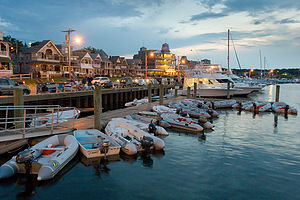 Oak Bluffs Marina WaterfrontLike Aquinnah with its Native American heritage and Edgartown with its heyday during the whaling days, Oak Bluffs also has a rich historical past, but one based on religion. I find this rather ironic, as today Oak Bluffs is the “party” town of the island.
Oak Bluffs Marina WaterfrontLike Aquinnah with its Native American heritage and Edgartown with its heyday during the whaling days, Oak Bluffs also has a rich historical past, but one based on religion. I find this rather ironic, as today Oak Bluffs is the “party” town of the island.
Although Oak Bluffs was first settled in 1642, its rapid growth occurred after the summer of 1835 when Methodists began coming to the island to hold revivalist meetings. This was the period of the Second Great Awakening, a religious revival movement that preached personal salvation through highly emotional outdoor revival meetings. During that first summer in 1835, the Methodists pitched their tents under a large grove of oaks in what is now Trinity Park and established the Martha’s Vineyard Camp Meeting. Each summer they returned to do the same, with the groups getting gradually larger and larger, and the time spent on the island longer and longer. Gradually these tents were replaced with small Victorian-style cottages, which became known as “Gingerbread Cottages” because of their fanciful bright colors and ornate moldings. By 1880, 315 cottages had been built in a circular pattern around the original meeting area. A permanent structure called the Tabernacle, with seating for over 3,000 people, was built in the center to allow camp meetings to take place regardless of the weather. The town was incorporated as Cottage City.
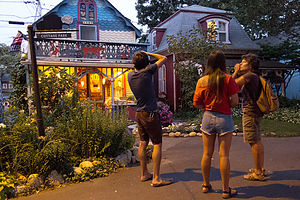 Andrew Photographing Gingerbread CottageI had been coming to the island – and Oak Bluffs -- for about 15 years before I first discovered this tiny city within a city. My excuse is that it is fairly well hidden and easily missed. The secret is to go through an alley between the stores on the western side of Circuit Avenue, or starting from the marina, go past the grand old Wesley Hotel into what is called the Martha’s Vineyard Camp Meeting Association, or just the “Campground”. It’s like you’ve entered a totally different world. But be careful not to get lost, because all the roads are in circles. I usually just pop out into the real world at random spots – sometimes Circuit Avenue, sometimes Lake Avenue near the marina.
Andrew Photographing Gingerbread CottageI had been coming to the island – and Oak Bluffs -- for about 15 years before I first discovered this tiny city within a city. My excuse is that it is fairly well hidden and easily missed. The secret is to go through an alley between the stores on the western side of Circuit Avenue, or starting from the marina, go past the grand old Wesley Hotel into what is called the Martha’s Vineyard Camp Meeting Association, or just the “Campground”. It’s like you’ve entered a totally different world. But be careful not to get lost, because all the roads are in circles. I usually just pop out into the real world at random spots – sometimes Circuit Avenue, sometimes Lake Avenue near the marina.
These houses are adorable and can be rented as vacation homes. I keep telling Herb that I want to do that some day.
 Cottage City Illumination NightDespite 30+ years of visiting the island, only once did our time here coincide with “The Grand Illumination,” the annual end-of-summer celebration held in the Campground each year on either the second or third Wednesday in August. This event has been taking place for over a century and is a definite must-do for anyone that loves this island. During the week leading up to the celebration, residents decorate their cottages with ornate Japanese and Chinese lanterns, each trying to outdo the next in their elaborateness. However, no one can light these lanterns until the appropriate time on Illumination Night. The evening begins with hundreds of people gathered in and around the Tabernacle for a very patriotic and inspiring sing-along band concert. At the end of the concert, anticipation builds as all the lights in the Tabernacle go out. Only then are the lanterns on the cottages dramatically “illuminated,” accompanied by the “oohs” and ahs” of an appreciative audience.
Cottage City Illumination NightDespite 30+ years of visiting the island, only once did our time here coincide with “The Grand Illumination,” the annual end-of-summer celebration held in the Campground each year on either the second or third Wednesday in August. This event has been taking place for over a century and is a definite must-do for anyone that loves this island. During the week leading up to the celebration, residents decorate their cottages with ornate Japanese and Chinese lanterns, each trying to outdo the next in their elaborateness. However, no one can light these lanterns until the appropriate time on Illumination Night. The evening begins with hundreds of people gathered in and around the Tabernacle for a very patriotic and inspiring sing-along band concert. At the end of the concert, anticipation builds as all the lights in the Tabernacle go out. Only then are the lanterns on the cottages dramatically “illuminated,” accompanied by the “oohs” and ahs” of an appreciative audience.
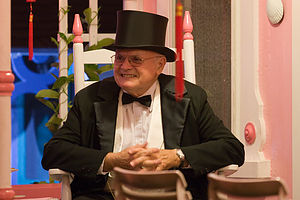 Man in Tux on Illumination NightThe celebration ends after visitors finish wandering through the Campground enjoying the magnificent display of lanterns. I am so envious of the people sitting in their rocking chairs on the porches of these adorable cottages. Renting one of these is now officially on my bucket list.
Man in Tux on Illumination NightThe celebration ends after visitors finish wandering through the Campground enjoying the magnificent display of lanterns. I am so envious of the people sitting in their rocking chairs on the porches of these adorable cottages. Renting one of these is now officially on my bucket list.
Before we discovered Cottage City, we came to Oak Bluffs with the boys when they were little primarily to let them ride the famous Flying Horses Carousel, the nation’s oldest continuously operating merry-go-round. The carousel was originally built in Coney Island, but moved to its current location in a red barn at the foot of Circuit Avenue in 1884. It really is a unique place and has even been designated a National Landmark. Each horse on the carousel is different and handcrafted with real horsehair and glass eyes.
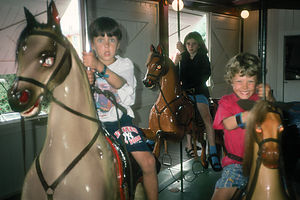 Andrew and Tommy riding Flying Horses CarouselWe have so many fond memories of this place. I think the boys rode these horses every year from their birth until they were in their teens. One time that particularly stands out in my mind occurred when Tommy was 2 years old. During this phase of his life, he had the odd habit of wanting to clutch an item in his hand – in a tiny death grip – and hold onto it for hours on end. One time, he chose to carry around a portable Latin dictionary for days – everyone thought he was gifted. On this particular vacation he chose a small children’s Tylenol bottle and carried it around for the entire week. We still have movies of him riding the carousel, stretching his little hand out to reach the brass ring, while simultaneously clutching his medication in the other. It was so embarrassing.
Andrew and Tommy riding Flying Horses CarouselWe have so many fond memories of this place. I think the boys rode these horses every year from their birth until they were in their teens. One time that particularly stands out in my mind occurred when Tommy was 2 years old. During this phase of his life, he had the odd habit of wanting to clutch an item in his hand – in a tiny death grip – and hold onto it for hours on end. One time, he chose to carry around a portable Latin dictionary for days – everyone thought he was gifted. On this particular vacation he chose a small children’s Tylenol bottle and carried it around for the entire week. We still have movies of him riding the carousel, stretching his little hand out to reach the brass ring, while simultaneously clutching his medication in the other. It was so embarrassing.
The other thing to dread is one of your children being lucky enough to grasp the brass ring and win a free ride, because “free” actually means having to pay for another ride for the other child who was not as fortunate. This can go on for quite a few “free” rides.
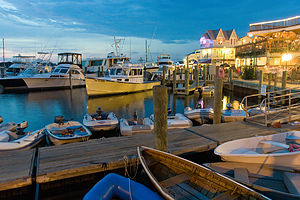 Oak Bluffs MarinaAs I mentioned before, Oak Bluffs is probably the liveliest town on the island. A walk along the docks by the harbor in summertime takes you past some pretty rowdy bars and restaurants. There are also numerous restaurants, shops, movie theaters, arcades, and bars along the main drag – Circuit Avenue.
Oak Bluffs MarinaAs I mentioned before, Oak Bluffs is probably the liveliest town on the island. A walk along the docks by the harbor in summertime takes you past some pretty rowdy bars and restaurants. There are also numerous restaurants, shops, movie theaters, arcades, and bars along the main drag – Circuit Avenue.
Last summer, when Andrew and Celeste came to join us on the island for a weekend, we experienced another Vineyard first for us – which after 30 years is getting more and more difficult. We were having dinner at a microbrewery called the Offshore Ale Co. on Kennebec Avenue (one block over from Circuit Ave), when we began getting whiffs of some very incredible bakery smells. It was so good that we just had to ask our waitress where it was coming from. “Oh, Back Door Donuts has started their baking for tomorrow morning,” she said and pointed up the street.
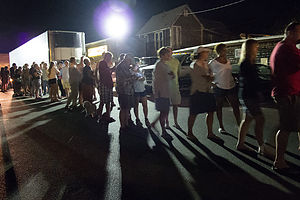 The Line for Back Door DonutsImmediately upon finishing our dinner, we followed the aroma of donuts up the street, only to find a line of people that stretched about a 100 yards through a parking lot and up to a small window in the back of a building. Without even thinking twice we got on the back of the line. Seeing that we were obvious newbies to this process, several people near us in line gave us some advice. We even ran into a neighbor from New Jersey about 6 people back, who comes and waits on this line each year when she comes to the island. I was a bit embarrassed that we had been coming to the island for so long, and never knew this was occurring each night in Oak Bluffs.
The Line for Back Door DonutsImmediately upon finishing our dinner, we followed the aroma of donuts up the street, only to find a line of people that stretched about a 100 yards through a parking lot and up to a small window in the back of a building. Without even thinking twice we got on the back of the line. Seeing that we were obvious newbies to this process, several people near us in line gave us some advice. We even ran into a neighbor from New Jersey about 6 people back, who comes and waits on this line each year when she comes to the island. I was a bit embarrassed that we had been coming to the island for so long, and never knew this was occurring each night in Oak Bluffs.
Apple fritters was the unanimous recommendation, so we decided that we would get four of them. As we slowly inched our way along the line, the continuous stream of tempting aromas did something to our brains that made us keep adding to our intended order. We were now up to four fritters and four donuts. Hopefully, this wouldn’t take too much longer or we would be adding cinnamon buns as well. When it was finally our turn, we were kind of nervous, fearing we would mess up our order and be denied our treats – “No fritter for you!” -- just like the “Soup Nazi” Seinfeld episode. But we managed to hold ourselves together and achieve the prize.
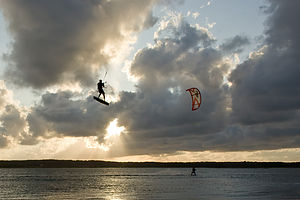 Kite Boarders on Sengekontacket PondWe didn’t even make it to the corner before diving in. While I must say, the donuts were really good, the apple fritters were incredible. A new Vineyard tradition had been born.
Kite Boarders on Sengekontacket PondWe didn’t even make it to the corner before diving in. While I must say, the donuts were really good, the apple fritters were incredible. A new Vineyard tradition had been born.
Oak Bluffs is also home to one of the two “Chops” on the northern part of the island. Many times we have parked in Oak Bluffs and gone for a run that includes circling the chop. The run is nice, gradually ascending from town to the top of a prominent bluff overlooking Nantucket Sound to the north and Vineyard Haven Harbor to the west. In fact, the bluff is the source of the name Oak Bluffs. There are no stores or businesses of any kind along the Chop, just very enviable, mid-1800 mansions with some really great views. At the very northern end of the Chop, atop Telegraph Hill, stands the East Chop Lighthouse, one of the island’s five.
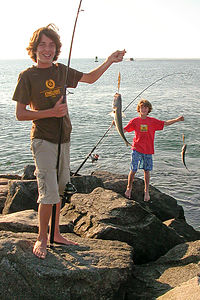 Boys catching fish from JettyThere are 3 (or more correctly 2 ½, as one is shared with Edgartown) public beaches in Oak Bluffs: Eastville Beach on the west side of East Chop, Town Beach to the east of the Steam Ship Authority dock, and Joseph Sylvia State Beach (or more popularly, just plain old State Beach) along the road to Edgartown. State Beach, by far, is the most popular one. It is very long and narrow, extending for two miles along the state highway that connects Oak Bluffs and Edgartown. The Nantucket Sound shoreline lies on one side of the road and Sengekontacket Pond on the other. During the summer, cars fill the parking lane that runs the length of the beach.
Boys catching fish from JettyThere are 3 (or more correctly 2 ½, as one is shared with Edgartown) public beaches in Oak Bluffs: Eastville Beach on the west side of East Chop, Town Beach to the east of the Steam Ship Authority dock, and Joseph Sylvia State Beach (or more popularly, just plain old State Beach) along the road to Edgartown. State Beach, by far, is the most popular one. It is very long and narrow, extending for two miles along the state highway that connects Oak Bluffs and Edgartown. The Nantucket Sound shoreline lies on one side of the road and Sengekontacket Pond on the other. During the summer, cars fill the parking lane that runs the length of the beach.
There is also a bike path that runs parallel to the road on the Pond side.
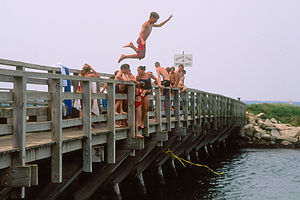 Tommy jumping off Memorial BridgeThere are two bridges along this road going over inlets connecting the Sound to the Pond. On any summer day, you will find dozens of kids of all ages perched atop the rail of the American Legion Memorial Bridge, jumping off into the inlet. One summer we convinced the boys that doing so would make them true “islanders,” so they did. For movie buffs, this inlet might be familiar as the site of a shark attack in the movie Jaws.
Tommy jumping off Memorial BridgeThere are two bridges along this road going over inlets connecting the Sound to the Pond. On any summer day, you will find dozens of kids of all ages perched atop the rail of the American Legion Memorial Bridge, jumping off into the inlet. One summer we convinced the boys that doing so would make them true “islanders,” so they did. For movie buffs, this inlet might be familiar as the site of a shark attack in the movie Jaws.
Over the years, we have spent many days at State Beach. It is not necessarily my favorite beach in that it doesn’t have the surf that South Beach in Edgartown has, or the grandeur and beauty of Moshup Beach in Aquinnah, or the fishing to be found at Wasque on Chappaquiddick. However, it is a lovely beach and a good place for us to set up base camp with the RV. In the summer this means getting there early in the morning or waiting until late afternoon when most beachgoers have called it a day.
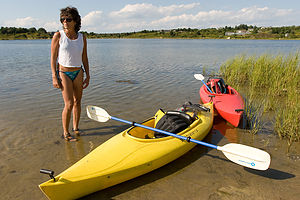 Lolo with boys kayaks on Sengekontacket PongAlthough we have parked along the road, we usually try to get a space in the small parking lot on the Oak Bluffs end of the beach. We back it in with our back window overlooking the Pond. There have been so many times that we have spent the evening here, cooking dinner and watching the sun set over the Pond.
Lolo with boys kayaks on Sengekontacket PongAlthough we have parked along the road, we usually try to get a space in the small parking lot on the Oak Bluffs end of the beach. We back it in with our back window overlooking the Pond. There have been so many times that we have spent the evening here, cooking dinner and watching the sun set over the Pond.
There are a lot of things to do from here, besides just hanging on the beach. In past years, we have brought a windsurfer to the island and practiced in Sengekontacket Pond, where we couldn’t be blown off to Nantucket. The Pond is very pretty and shallow, and a perfect place to learn. It’s also a nice place to kayak, which we have also done on a few occasions.
This parking lot is also a perfect base camp to bike ride either into Edgartown or to Oak Bluffs. Edgartown is about a 4 mile ride from here and Oak Bluffs about 2. This way we can go to town in the evening and not worry about finding parking for the RV.
Description
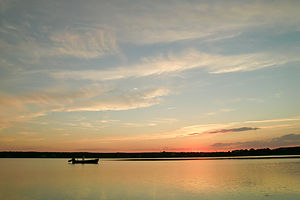 Sunset over Sengekontacket PondThe town of Oak Bluffs is located on the eastern chop on the northern shore of Martha’s Vineyard, with Nantucket Sound to its east and Vineyard Harbor to its west.
Sunset over Sengekontacket PondThe town of Oak Bluffs is located on the eastern chop on the northern shore of Martha’s Vineyard, with Nantucket Sound to its east and Vineyard Harbor to its west.
Its history is fascinating and probably the reason Martha’s Vineyard is such a popular vacation destination today. What is now Oak Bluffs was first settled in 1642 and functioned as a farming community for almost 200 years before Methodists came in the summer of 1835 to hold a revivalist meeting. This was the period of the Second Great Awakening, a religious revival movement that preached personal salvation through highly emotional outdoor revival meetings. During that first summer in 1835, the Methodists pitched their tents under a large grove of oaks in what is now Trinity Park and established the Martha’s Vineyard Camp Meeting. Each summer they returned to do the same, with the groups getting gradually larger and larger, and the time spent on the island longer and longer.
 Boys playing in Ocean ParkBy the 1860s, the tents began being replaced by small Victorian-style cottages, built in a circular pattern around the meeting area and as close together as the tents they replaced. These cottages became known as Gingerbread Cottages because of their fanciful bright colors and ornate moldings, which made them appear as props in a fairytale. By 1880, 315 cottages had been built and the town was incorporated as Cottage City. A permanent structure called the Tabernacle, with seating for over 3,000 people, was built in the center to allow camp meetings to take place regardless of the weather. The Gingerbread Houses and Tabernacle are still there today, but as vacation homes and a community center.
Boys playing in Ocean ParkBy the 1860s, the tents began being replaced by small Victorian-style cottages, built in a circular pattern around the meeting area and as close together as the tents they replaced. These cottages became known as Gingerbread Cottages because of their fanciful bright colors and ornate moldings, which made them appear as props in a fairytale. By 1880, 315 cottages had been built and the town was incorporated as Cottage City. A permanent structure called the Tabernacle, with seating for over 3,000 people, was built in the center to allow camp meetings to take place regardless of the weather. The Gingerbread Houses and Tabernacle are still there today, but as vacation homes and a community center.
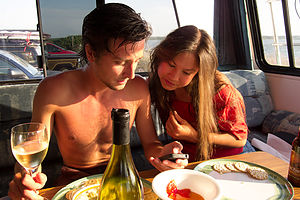 Andrew and Celeste dining in RV at State BeachAnother old tradition on the island dating back to 1868 is the Vineyard Haven Band, made up of a group of Civil War veterans (both Confederate and Union soldiers). In 1878, the Oak Bluffs gazebo in Ocean Park was built to serve as a bandstand for the Band. The gazebo is still used today for summer concerts.
Andrew and Celeste dining in RV at State BeachAnother old tradition on the island dating back to 1868 is the Vineyard Haven Band, made up of a group of Civil War veterans (both Confederate and Union soldiers). In 1878, the Oak Bluffs gazebo in Ocean Park was built to serve as a bandstand for the Band. The gazebo is still used today for summer concerts.
In 1884, the Flying Horses Carousel was moved from Coney Island in New York to a red barn at the foot of Circuit Avenue in Cottage City. Constructed by Charles Dare, each horse is unique and handcrafted with real horsehair and glass eyes. Children (and adults) today still enjoy taking a ride on the carousel. It is the nation’s oldest continuously operating merry-go-round and has been designated a National Landmark.
 Circuit Ave CottagesIn 1907, to reflect the growing population and the changing face of the resort, the town’s name was changed from Cottage City to Oak Bluffs because the town was the site of an oak grove along the bluffs overlooking the Sound.
Circuit Ave CottagesIn 1907, to reflect the growing population and the changing face of the resort, the town’s name was changed from Cottage City to Oak Bluffs because the town was the site of an oak grove along the bluffs overlooking the Sound.
Today Oak Bluffs is a bustling resort town with lots of restaurants, inns, shops, movie theaters, arcades, and bars to enjoy live entertainment and dancing. Ironically, what once started as a place of prayer is now one of the liveliest towns on this otherwise very reserved island. Circuit Avenue is the main drag through town and where most of the action is.
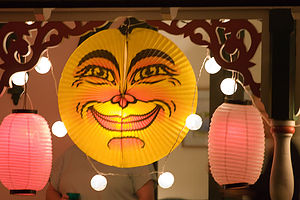 Illumination Night LanternOak Bluffs also operates the largest marina on the island. Situated in Oak Bluffs Harbor, this bustling marina is in walking distance to Circuit Avenue and the historical gingerbread houses in the Martha’s Vineyard Camp Meeting Association. There are also several pretty rowdy bars and restaurants located alongside the dock.
Illumination Night LanternOak Bluffs also operates the largest marina on the island. Situated in Oak Bluffs Harbor, this bustling marina is in walking distance to Circuit Avenue and the historical gingerbread houses in the Martha’s Vineyard Camp Meeting Association. There are also several pretty rowdy bars and restaurants located alongside the dock.
When in Oak Bluffs, be sure to take a stroll through the old Camp Meeting Grounds to see the gingerbread houses and the Tabernacle. Visitors to the Cottage Museum can view the interior of one of these cottages, complete with period furnishings, and learn more about the history of the Campground. In 2005, the grounds and buildings in the Campground were designated a National Historic Landmark.
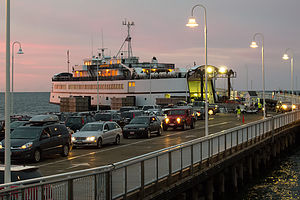 MV Ferry at Oak BluffsOn a Wednesday night in either the second or third week in August, the Campground is the site of “The Grand Illumination,” an annual end-of-summer celebration where residents decorate their cottages with ornate Japanese and Chinese lanterns, each trying to outdo the next in their elaborateness. The lanterns remain dark while people gather in the Tabernacle for a sing-along band concert. At the end of the concert, all the lights in the Tabernacle go out and then the lanterns on the cottages are dramatically “illuminated.” The celebration ends after visitors finish wandering through the Campground enjoying the magnificent display of lanterns. The Grand Illumination has been taking place for over a century. It was initially intended to mark the visit of the Governor of Massachusetts.
MV Ferry at Oak BluffsOn a Wednesday night in either the second or third week in August, the Campground is the site of “The Grand Illumination,” an annual end-of-summer celebration where residents decorate their cottages with ornate Japanese and Chinese lanterns, each trying to outdo the next in their elaborateness. The lanterns remain dark while people gather in the Tabernacle for a sing-along band concert. At the end of the concert, all the lights in the Tabernacle go out and then the lanterns on the cottages are dramatically “illuminated.” The celebration ends after visitors finish wandering through the Campground enjoying the magnificent display of lanterns. The Grand Illumination has been taking place for over a century. It was initially intended to mark the visit of the Governor of Massachusetts.
Another distinctive area in Oak Bluffs is East Chop, a residential area on a peninsula, surrounded by Nantucket Sound on the north and east and Vineyard Haven Harbor on the west. It features a high prominent bluff (hence the name Oak Bluffs), with mid-1800 mansions overlooking the Sound. East Chop Light, one of the island’s five lighthouses, stands on Telegraph Hill at the north end of the chop.
There are 2 ½ public beaches (State Beach is shared with Edgartown) in Oak Bluffs (all on the calm waters of Nantucket Sound):
- Eastville Beach – located at the bridge between Oak Bluffs and Vineyard Haven on the west side of East Chop
- Oak Bluffs Town Beach – located between the Steam Ship Authority dock and the first jetty towards Edgartown
- Joseph Sylvia State Beach (more often referred to as State Beach) - extends for two miles along the state highway connecting Oak Bluffs and Edgartown. The Nantucket Sound shoreline lies on one side of the road and Sengekontacket Pond on the other. The calm waters of the Sound and the Pond make this a very popular beach for families. Parking is available along the paved parking lane that runs the length of the beach. A paved bike path on the Pond side connects the towns of Edgartown and Oak Bluffs.
Kayaking opportunities:
- Sengekontacket Pond
- Lagoon Pond
Tisbury
Tuesday, July 1, 2008 - 10:45am by Lolo0 miles and 0 hours from our last stop - 1 night stay
Travelogue
 Lolo on early morning ferry from Woods HoleVineyard Haven (the name most people substitute for Tisbury) is the first place that most visitors to the island see. It is the major terminal for the Steamship Authority, which delivers thousands of visitors to the island each day on its fleet of large ferries. Ferries also run to Oak Bluffs and Edgartown, but most people come through this port.
Lolo on early morning ferry from Woods HoleVineyard Haven (the name most people substitute for Tisbury) is the first place that most visitors to the island see. It is the major terminal for the Steamship Authority, which delivers thousands of visitors to the island each day on its fleet of large ferries. Ferries also run to Oak Bluffs and Edgartown, but most people come through this port.
Vineyard Haven is located on the northern shore of Martha’s Vineyard, with its harbor safely nestled between the West and East Chops. This deep protected harbor helped it become one of the busiest ports in early New England. In centuries past, it served as a popular port for vessels selling whale oil, candles, salt cod, and wool to customers in Europe and up and down the American coast. That deep maritime tradition is still readily apparent today by the wooden schooners anchored in the harbor. Vineyard Haven is home to one of the last wooden boat shipyards in America, where boats are still built with the tools used centuries ago.
 Small Craft on beach outside the Black Dog TavernThe opening of the Cape Cod Canal in 1914 and the increased usage of trains, trucks, and steamships to move cargo greatly reduced the number of ships using Vineyard Haven as a port. However, today the town is still hopping with activity as Vineyard Haven has shifted to importing a different kind of cargo – tourists.
Small Craft on beach outside the Black Dog TavernThe opening of the Cape Cod Canal in 1914 and the increased usage of trains, trucks, and steamships to move cargo greatly reduced the number of ships using Vineyard Haven as a port. However, today the town is still hopping with activity as Vineyard Haven has shifted to importing a different kind of cargo – tourists.
My most vivid and personal memory of pulling into this wonderful harbor was 9:00 pm on the night of September 26, 1985, as we caught the last ferry from Woods Hole to the island before it shut down because of Hurricane Gloria. The reason we were so anxious to make the crossing was that Herb and I were getting married that Saturday in Edgartown. This was not the way I planned to arrive as a bride on the island. Instead of going up on Friday for our Saturday wedding as planned, we (meaning me and Herb, my parents, and his) raced up to get to Woods Hole on Thursday night before the ferries shut down. At this point we thought that the six of us might be the only attendees. The winds were already getting pretty fierce at 70 mph and the crossing was very rough, but we made it. Maybe we were foolish, but Herb and I had already been dating for 11 years, and I was not about to do anything that would jeopardize this long-awaited event. Well, we made it safely and so did many of our guests the following night, but that is a story to be told in the Edgartown stop.
 Herb holding up Black Dog Tavern Sign - LEGEnough wedding talk. Back to some of our memories and experiences in Vineyard Haven.
Herb holding up Black Dog Tavern Sign - LEGEnough wedding talk. Back to some of our memories and experiences in Vineyard Haven.
One of the sights you can see as your ferry arrives, if you know enough to look for it, is the iconic Black Dog Tavern, a restaurant probably more famous for its ubiquitous t-shirts than for its food – which by the way is wonderful. This is a place that we have been coming back to year after year for almost three decades. In the early days, we would come for dinner. The wait was always long, but that was okay. It was a BYO restaurant, and they would give you wine glasses while you waited outside by the beach. That became half the fun. In more recent years, we have discovered their wonderful breakfasts and lunches, which are a much better bargain compared to dinner.
We tend to spend most of our island time in Edgartown and Chappy, so I don’t know Vineyard Haven as well. However, we do have a few Vineyard Haven highlights from our annual trips.
 Murdick’s Run the Chop 5 Mile Race StartOne such highlight was our participation in our first island road race -- the Murdick’s Run the Chop 5 Mile Race in July of 2006. Murdick’s is the famous Fudge shop on the island. The boys were running track in high school at the time, and Herb and I have always been avid runners, so we thought it was about time we combined our love or running with our love of the Vineyard, plus my love of fudge. Unfortunately for Herb, his back was out, so he became the designated photographer. Also, Andrew had just gotten over a fever, but decided to run anyway, even though he was feeling a bit under the weather. It was great. I really felt like a local, gathering at the starting line with people that all seemed to know each other. And the run itself was a great way to see the Chop. There are some really beautiful houses overlooking the Sound. I run better when I am diverted and looking at nice scenery.
Murdick’s Run the Chop 5 Mile Race StartOne such highlight was our participation in our first island road race -- the Murdick’s Run the Chop 5 Mile Race in July of 2006. Murdick’s is the famous Fudge shop on the island. The boys were running track in high school at the time, and Herb and I have always been avid runners, so we thought it was about time we combined our love or running with our love of the Vineyard, plus my love of fudge. Unfortunately for Herb, his back was out, so he became the designated photographer. Also, Andrew had just gotten over a fever, but decided to run anyway, even though he was feeling a bit under the weather. It was great. I really felt like a local, gathering at the starting line with people that all seemed to know each other. And the run itself was a great way to see the Chop. There are some really beautiful houses overlooking the Sound. I run better when I am diverted and looking at nice scenery.
 Herring Creek Beach HousesWe had a very respectable finish – Andrew and Tommy took 1st and 2nd in their age class and I took first in the old lady category. At the awards ceremony, we were each handed a piece of paper that said “Congratulation - #1 Murdick’s Fudge.” Woopie, I thought. Murdick’s thinks we’re number 1. Then a light bulb went off in my head and I realized that # also meant pound, and we had just won 3 pounds of fudge. Now, we’re talking. Any weight I might have lost during the race was quickly replaced with our winnings.
Herring Creek Beach HousesWe had a very respectable finish – Andrew and Tommy took 1st and 2nd in their age class and I took first in the old lady category. At the awards ceremony, we were each handed a piece of paper that said “Congratulation - #1 Murdick’s Fudge.” Woopie, I thought. Murdick’s thinks we’re number 1. Then a light bulb went off in my head and I realized that # also meant pound, and we had just won 3 pounds of fudge. Now, we’re talking. Any weight I might have lost during the race was quickly replaced with our winnings.
Since that race, we have ridden our bikes around West Chop several times. It’s a very nice part of the island, but definitely feels more year-round than Edgartown and Oak Bluffs. It reminds me a bit of parts of the Cape. There is a great view out over the sound from the West Chop Lighthouse, which sits atop a 60-foot bluff overlooking the Sound.
 Lolo keeping Tommy's toes from Crabbies in Lake TashmooOn our route around the Chop, we often head west on Herring Creek Road to get to Lake Tashmoo. Herring Creek Road eventually turns to sand, but is still navigable by car or bike. At the very end of the road is a small channel, or I guess Herring Creek, where the ocean flows into the lake. One can choose to swim either on lifeguarded Herring Creek Beach on Vineyard Sound or in Lake Tashmoo.
Lolo keeping Tommy's toes from Crabbies in Lake TashmooOn our route around the Chop, we often head west on Herring Creek Road to get to Lake Tashmoo. Herring Creek Road eventually turns to sand, but is still navigable by car or bike. At the very end of the road is a small channel, or I guess Herring Creek, where the ocean flows into the lake. One can choose to swim either on lifeguarded Herring Creek Beach on Vineyard Sound or in Lake Tashmoo.
In years past we used to cruise into Lake Tashmoo in our Grady White for an evening cocktail hour. It’s very shallow, so we used to anchor and walk to shore. When Tommy was little, he refused to even put his toe in this water because of the “crabbies.” I guess it is a good place for crabbing as are many of the other ponds on the island.
One time we even brought kayaks on top of our Suburban and paddled around the Lake to look at possible rental houses for the next summer. The problem was that we had two small kayaks and four people, or rather two adults and two small children. I definitely do not recommend paddling into the wind with a small, wiggling child in your lap. We were practically going backwards. Now that we have better kayaks and grown-up children, I would like to explore this lake a little more leisurely.
 Happy Campers at Martha's Vineyard Family CampgroundVineyard Haven is also home to the only campground on the island: the Martha’s Vineyard Family Campground located on the Edgartown-Vineyard Haven Road. It’s a pretty big campground and quite nice – very busy in the summer, so reservations are needed quite a bit in advance. Since we are kind of nomads on the island – moving the RV to a beach early in the morning and then returning late at night – we have spent very little time actually enjoying what really is a very lovely campground. At $58 a night for an RV site, it is not cheap, but it is still by far the biggest bargain on the island.
Happy Campers at Martha's Vineyard Family CampgroundVineyard Haven is also home to the only campground on the island: the Martha’s Vineyard Family Campground located on the Edgartown-Vineyard Haven Road. It’s a pretty big campground and quite nice – very busy in the summer, so reservations are needed quite a bit in advance. Since we are kind of nomads on the island – moving the RV to a beach early in the morning and then returning late at night – we have spent very little time actually enjoying what really is a very lovely campground. At $58 a night for an RV site, it is not cheap, but it is still by far the biggest bargain on the island.
Description
 Family before Murdick's 5 Mile RaceTisbury, better known as Vineyard Haven, is the main port of entrance to Martha's Vineyard and often the first place that visitors to the island see. It is located on the northern shore of Martha’s Vineyard, bordered by Vineyard Sound to the north, Oak Bluffs to the east, and West Tisbury to the southwest. Its harbor, protected by the two headlands of West Chop and East Chop, serves as the major terminal for the Steamship Authority, which ferries visitors to the island from Woods Hole and New Bedford. It is the most year-round community on the island, with a population of about 3,700 people and a busy schedule of community events all year. Most of its stores and restaurants remain open during the winter.
Family before Murdick's 5 Mile RaceTisbury, better known as Vineyard Haven, is the main port of entrance to Martha's Vineyard and often the first place that visitors to the island see. It is located on the northern shore of Martha’s Vineyard, bordered by Vineyard Sound to the north, Oak Bluffs to the east, and West Tisbury to the southwest. Its harbor, protected by the two headlands of West Chop and East Chop, serves as the major terminal for the Steamship Authority, which ferries visitors to the island from Woods Hole and New Bedford. It is the most year-round community on the island, with a population of about 3,700 people and a busy schedule of community events all year. Most of its stores and restaurants remain open during the winter.
Vineyard Haven has a deep maritime tradition. It served as a popular port for vessels selling whale oil, candles, salt cod, and wool to customers in Europe and up and down the American coast. It became one of early New England’s busiest ports, and sailors from around the world knew Martha’s Vineyard through the Seaman’s Bethel.
 Schooner sailing from deck of MV FerryAs a reminder of its maritime past, one of the first sights visitors to the island see as they approach Vineyard Haven are the schooners Shenandoah and Alabama anchored in the harbor. The village is also home to the Gannon and Benjamin Marine Railway, one of the few remaining wooden ship boatyards in America, where boats are still built with the tools used a century or two ago. Vineyard Haven Harbor is home to more wooden boats than any other harbor in America.
Schooner sailing from deck of MV FerryAs a reminder of its maritime past, one of the first sights visitors to the island see as they approach Vineyard Haven are the schooners Shenandoah and Alabama anchored in the harbor. The village is also home to the Gannon and Benjamin Marine Railway, one of the few remaining wooden ship boatyards in America, where boats are still built with the tools used a century or two ago. Vineyard Haven Harbor is home to more wooden boats than any other harbor in America.
The town of Tisbury, which was first called Holmes Hole, was first incorporated within the Commonwealth of Massachusetts in 1671. In 1700 it was home to three families, but by 1780 it had already grown to a thriving port with 21 inns to welcome visitors to the island. By the mid 19th century, it was second only to the English Channel in number of ships stopping on their way to and from Europe, Africa, and the West Indies. However, in the 1900s, the number of vessels using Vineyard Haven as a port decreased as the usage of trains, trucks, and steamships to move cargo increased. Also, the opening of the Cape Cod Canal in 1914 provided a shortcut for ship traffic, diverting it away from Vineyard Sound.
 Lolo crossing road to Tisbury ShopsToday, tourism has replaced shipping as the island’s main industry, and Vineyard Haven has shifted to becoming a port for a different kind of cargo – tourists.
Lolo crossing road to Tisbury ShopsToday, tourism has replaced shipping as the island’s main industry, and Vineyard Haven has shifted to becoming a port for a different kind of cargo – tourists.
Today Main Street is lined with galleries, shops, restaurants, and coffee shops, and of course the famous Bunch of Grapes bookstore, where Bill and Hillary Clinton have done book signings and President Obama takes his family to purchase some summer reading. Two blocks away on Church Street, the Vineyard Playhouse provides a full calendar of live theater events throughout the year.
The Clintons and the Obamas are not the only famous visitors to Vineyard Haven, which has become a popular summer destination for the rich and famous, especially those with a literary or journalistic bent. Summer residents have included Carly Simon, Thornton Wilder, Dashiel Hammett, Lillian Hellman, William Styron, Mike Wallace, Art Buchwald, Diane Sawyer, and Mike Nichols.
 Lolo post breakfast at the Black Dog TavernEach July during the Tisbury Street Fair, Main Street is closed off and becomes a party scene, complete with bands, food, and bargains from the shops that line it.
Lolo post breakfast at the Black Dog TavernEach July during the Tisbury Street Fair, Main Street is closed off and becomes a party scene, complete with bands, food, and bargains from the shops that line it.
Vineyard Haven is also home to the iconic Black Dog Tavern, famous for its good food and popular t-shirts sporting a black dog, which can be worn by people throughout the U.S.
The Main Street of Vineyard Haven lies at the base of West Chop, the Vineyard’s northernmost headlands, which juts out into Vineyard Sound with sweeping views of Cape Cod and the Elizabeth Islands. Atop a 60-foot bluff at the very tip of the headlands stands the West Chop lighthouse. The original wooden lighthouse built in 1817 was replaced by a brick structure in 1838. Due to erosion, it had to be moved back twice, once in 1848 and again in 1891.
 Lolo on pond off State RoadFor a different type of beach experience, head west on Herring Creek Road. After a bit, the road turns to sand but is still navigable by car or bike. Herring Creek Beach is the only spot on the island where ocean meets lake, and one can choose to swim in either the Vineyard Sound or Lake Tashmoo.
Lolo on pond off State RoadFor a different type of beach experience, head west on Herring Creek Road. After a bit, the road turns to sand but is still navigable by car or bike. Herring Creek Beach is the only spot on the island where ocean meets lake, and one can choose to swim in either the Vineyard Sound or Lake Tashmoo.
There are three public beaches in Vineyard Haven:
- Owen Park Beach – a harbor beach located just a short walk from downtown
- Vineyard Haven Harbor – narrow strip of land between the Black Dog Tavern and the Steamship Authority
- Herring Creek Beach – located on Lake Tashmoo and the Vineyard Sound at the end of Herring Creek Road
Kayaking opportunities:
- Lake Tashmoo
Tisbury is also home to the only campground on the island – the Martha’s Vineyard Family Campground, located just one and a half miles from the Vineyard Haven ferry terminal on the Edgartown-Vineyard Haven Road. The campground has spacious wooded sites as well as rustic cabins. Other amenities include modern restrooms with hot showers, laundromat, store, recreation hall and playground.
Hayward and flight Home
Monday, June 4, 2012 - 9:15am by Lolo172 miles and 3.5 hours from our last stop - 1 night stay
Travelogue
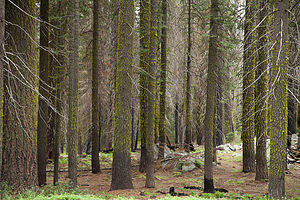 Leaving Yosemite ValleyWe were barely outside the gates of Yosemite before it began to rain, making it a little bit easier to part. Our only objective for the remainder of the day was to find a place to stay in striking distance to San Francisco Airport, so as we got closer, I used Herb’s droid to search Kayak.com for hotels en route. I don’t know how people ever survived without smart phones.
Leaving Yosemite ValleyWe were barely outside the gates of Yosemite before it began to rain, making it a little bit easier to part. Our only objective for the remainder of the day was to find a place to stay in striking distance to San Francisco Airport, so as we got closer, I used Herb’s droid to search Kayak.com for hotels en route. I don’t know how people ever survived without smart phones.
We like the kayak app because it does all the searching of different travel sites for you and presents you with all the deals. Usually, I don’t book through the app, though I could, but just use it to get prices and phone numbers.
We found a good deal at a Days Inn in Hayward, about an hour from the airport. The neighborhood was a bit dicey, but the room was really great. We spent the evening sorting and packing for our early morning flight. The one problem with flying home is that you have to leave all the food, snacks, and wine behind. I am sure the maid was very happy the next morning to find all the goodies we left in the refrigerator.
Herb and I are still awed by the miracle of flight and the fact that we were back in New Jersey by early evening. Still, I did feel a bit guilty when I saw the RV sitting all alone in the backyard. Maybe next time.
Description
Quick stop on the eastern shore of San Francisco Bay within easy striking distance to the airport.
Yosemite Valley
Saturday, June 2, 2012 - 8:45am by Lolo75 miles and 2 hours from our last stop - 2 night stay
Travelogue
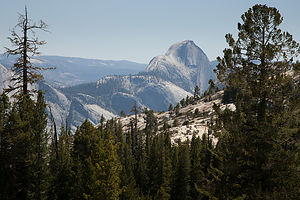 Back of Half Dome from Tioga Pass RoadNo matter how many times I visit Yosemite, I will never cease to be awed. This year, Herb wanted to enter the park from the east and drive the 45-mile Tioga Road up over the pass and through Tuolemne Meadows before gradually descending towards the Valley. This route allows for a more gradual assimilation to the park’s grandeur, as opposed to the heart-stopping visual overload you get when emerging from the Wawona Tunnel in the west.
Back of Half Dome from Tioga Pass RoadNo matter how many times I visit Yosemite, I will never cease to be awed. This year, Herb wanted to enter the park from the east and drive the 45-mile Tioga Road up over the pass and through Tuolemne Meadows before gradually descending towards the Valley. This route allows for a more gradual assimilation to the park’s grandeur, as opposed to the heart-stopping visual overload you get when emerging from the Wawona Tunnel in the west.
The 56-mile Tioga Road from the East Gate through Tuolemne Meadows to Crane Flat is a drive full of superlatives with the largest subalpine meadow in the Sierra Nevada providing a lovely setting for the greatest concentration of granite domes in the world. Then there are the incredible vistas, my favorite being the panoramic view from Olmsted Point, where we got our first glimpse of our old friend Half Dome—not the familiar iconic image seen from the valley floor, but of its less familiar rounded derriere.
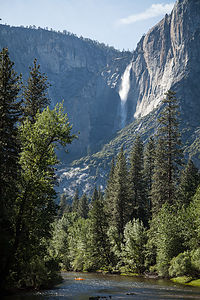 Yosemite Falls from Housekeeping Camp BridgeI was a little skeptical about our accommodations for the night. When we tried to book our stay a few days ago, the only thing available was Housekeeping Camp.
Yosemite Falls from Housekeeping Camp BridgeI was a little skeptical about our accommodations for the night. When we tried to book our stay a few days ago, the only thing available was Housekeeping Camp.
We have pretty much experienced every mode of habitation in Yosemite. From least to most luxurious – backpacking, tent camping, RV camping, Curry Village cabins, and my all time favorite, the Ahwahnee Hotel. Also, one hint: try to do them in this order, because once you are in the Ahwahnee, you are never going to want to leave.
So, this was going to be a new Yosemite experience. First let me say that the location of Housekeeping Camp is phenomenal – just a stone’s throw away from a nice sandy beach along the Merced River with terrific views of Yosemite Falls. The units (as they are romantically referred to) are pretty rustic. They consist of three concrete walls with the fourth wall being a canvas curtain that you can tie closed. The roof is canvas and extends out over a small patio area with a picnic table and a bear-proof food-storage box. Inside the “unit” is a bunk bed, double bed, small table, and a mirror. Linens for the bed are an extra $2.50 per night. Not exactly the Ahwahnee, but comfortable enough.
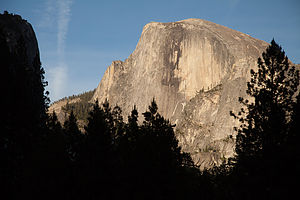 Half Dome from Ahwahnee MeadowI was a little jealous when we took a walk through the Camp. So many of the other units were so cozily decorated, with cute little outside lights, lamps from home, nice quilts, etc. – so warm and homey. Ours had more of a prison cell feel . But in all fairness, we were not prepared for this. My goal was to stay outside as much as possible.
Half Dome from Ahwahnee MeadowI was a little jealous when we took a walk through the Camp. So many of the other units were so cozily decorated, with cute little outside lights, lamps from home, nice quilts, etc. – so warm and homey. Ours had more of a prison cell feel . But in all fairness, we were not prepared for this. My goal was to stay outside as much as possible.
That evening Herb and I got a bottle of wine and some cheese and crackers and settled ourselves in the Ahwahnee Meadow to watch the sun set on Half Dome. Being seasoned veterans of sunsets in Yosemite, we knew enough to hang around after the granite face was in shadow, because the best was yet to come – the beautiful alpenglow that casts a reddish light on the previous darkened dome. I could watch this every night.
 Yosemite Falls and Merced RiverI also developed a new photographic technique, quite by accident. While trying to take a picture of Half Dome while lying on a blanket in the meadow, my knees got in the way. It is absolutely uncanny how much bare knees pressed together can look like butt cheeks. When I showed Herb my masterpiece, we laughed so hard it hurt. Maybe I was on to something – the next Ansel Adams.
Yosemite Falls and Merced RiverI also developed a new photographic technique, quite by accident. While trying to take a picture of Half Dome while lying on a blanket in the meadow, my knees got in the way. It is absolutely uncanny how much bare knees pressed together can look like butt cheeks. When I showed Herb my masterpiece, we laughed so hard it hurt. Maybe I was on to something – the next Ansel Adams.
A lovely evening in the meadow and a few glasses of wine helped make our Housekeeping unit seem a bit cozier.
The next day was a big one – the hike up to the top of Yosemite Falls. We had done this hike 26 years ago when we first came to Yosemite, but I think they made it higher and steeper since then. It is 7.2 miles RT and climbs over 2,700 feet.
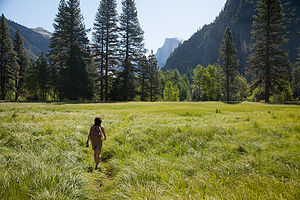 Lolo Hiking to Camp 4Yosemite Falls is the seventh highest waterfall in the world. If you count the lower falls as part of it, it would be the third largest. The falls drops 2,400 feet over the granite cliffs feeding the Merced River, which runs through the Valley. Late May is a particularly good time to do this hike because the snow melt is still keeping the falls roaring.
Lolo Hiking to Camp 4Yosemite Falls is the seventh highest waterfall in the world. If you count the lower falls as part of it, it would be the third largest. The falls drops 2,400 feet over the granite cliffs feeding the Merced River, which runs through the Valley. Late May is a particularly good time to do this hike because the snow melt is still keeping the falls roaring.
The trail begins next to Sunnyside Walk-in Campground (known to climbers as Camp 4), the rock climbers’ campground behind Yosemite Lodge. It’s interesting to just walk through this camp and see climbers from all over the world just hanging out or prepping to do some pretty incredible, or crazy depending on your viewpoint, stuff on the sheer rock walls. Every climber dreams of doing El Capitan or Half Dome, and Herb is one of them. He had been an avid climber in the 1980s, going to the Shawnagunks in New Paltz, NY, every Saturday for over 10 years. Then kids came along and that hobby got put on hold for awhile until they grew up to become his climbing partners. However today, all he had was me, and a pretty strenuous hike ahead of us.
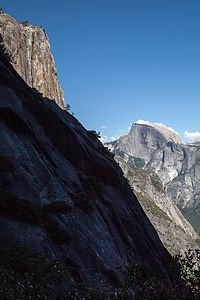 Half Dome from Yosemite Falls HikeThe first half mile of the hike climbs steeply along a series of over three dozen switchbacks through a dense pine forest. At the 1 mile point, there is a short spur trail to Columbia Rock, where there is a breathtaking, 180-degree view of Yosemite Valley from Half Dome in the east to the Cathedral Spires in the west. We met a nice couple here from North Carolina, who were in the process of negotiating whether to continue to the top or to call it a day. It really is a very strenuous hike, and Columbia Rock is a very noteworthy and respectable destination in itself.
Half Dome from Yosemite Falls HikeThe first half mile of the hike climbs steeply along a series of over three dozen switchbacks through a dense pine forest. At the 1 mile point, there is a short spur trail to Columbia Rock, where there is a breathtaking, 180-degree view of Yosemite Valley from Half Dome in the east to the Cathedral Spires in the west. We met a nice couple here from North Carolina, who were in the process of negotiating whether to continue to the top or to call it a day. It really is a very strenuous hike, and Columbia Rock is a very noteworthy and respectable destination in itself.
In that one mile we had already climbed 1,000 feet in elevation. Herb had his altimeter watch on and I kept asking him every few minutes for our progress. I need constant reinforcement. We had still not gotten a glimpse of the waterfalls. In fact, our first indication that we were getting closer to the falls was by hearing it, before we rounded a bend and it finally came into view.
The last quarter mile before reaching the top is a serious of torturous, seemingly endless switchbacks. I was so happy to finally reach the top. My thighs were screaming. From the top, there was a short, but intimidating, series of steps cut into the rockface, which led down to the Yosemite Fall Overlook. This was a real white knuckler -- for me anyway -- as I clutched the guardrail and looked out over the steep drop below. From the overlook we looked down from above at the falls cascading over the edge.
 Yosemite Falls and Half DomeBack up the creepy stairs, we were on the surprisingly flat top of land above the falls. From there we crossed the footbridge over the creek and hiked another .8 miles to Yosemite Point (along the trail to North Dome). My 7.2 mile RT hike was quickly changing to an 8.8er. However, it was worth the extra steps, because besides another incredible panorama of the Valley, we had a great unobstructed view of the Lost Arrow Spire, a really unique rock spire rising from the valley floor. This too is another classic climbing route, but unfortunately we did not see any climbers on it today.
Yosemite Falls and Half DomeBack up the creepy stairs, we were on the surprisingly flat top of land above the falls. From there we crossed the footbridge over the creek and hiked another .8 miles to Yosemite Point (along the trail to North Dome). My 7.2 mile RT hike was quickly changing to an 8.8er. However, it was worth the extra steps, because besides another incredible panorama of the Valley, we had a great unobstructed view of the Lost Arrow Spire, a really unique rock spire rising from the valley floor. This too is another classic climbing route, but unfortunately we did not see any climbers on it today.
A well deserved break was needed, so we hiked back to the creek and then went upstream a bit to relax and have lunch. It would have been tempting to take a dip, but the thought of being swept over the edge of the falls kept me on dry land.
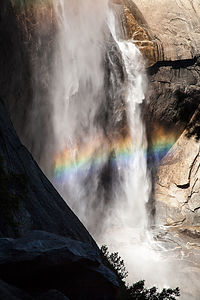 Rainbow at Base of Yosemite FallsAs always, the hike down a steep trail is almost worse than the way up—much tougher on the knees. After much groaning, and asking Herb every five minutes for our progress on his altimeter, we once again reached Camp 4 and limped our way back to our car, which was parked across the meadow at Swinging Bridge – technically making my total mileage closer to 10. I was very exhausted and expected to be in much pain tomorrow.
Rainbow at Base of Yosemite FallsAs always, the hike down a steep trail is almost worse than the way up—much tougher on the knees. After much groaning, and asking Herb every five minutes for our progress on his altimeter, we once again reached Camp 4 and limped our way back to our car, which was parked across the meadow at Swinging Bridge – technically making my total mileage closer to 10. I was very exhausted and expected to be in much pain tomorrow.
Back at Housekeeping Camp, we hung out on the beach for awhile and took a refreshing dip in the river, which washed away much of the trail dust accumulated over the day. After a real shower back in camp, we headed out, equipped once again with wine and cheese, to enjoy our last night in Yosemite. Rather than watch the sun set over Half Dome again, we chose to give El Capitan, the other great monolith in the park, our respect. So, we settled in El Cap Meadow and watched the sun go down on the tiny, tiny climbers on the wall. Much to Herb’s amusement, I continued trying to perfect my new photographic technique.
Another lovely evening in the Valley.
We really were in no particular hurry to leave the next morning. The only thing we needed to do that day was to get to a motel near enough to San Francisco Airport to catch a flight home very early the next morning. So, we hung by the beach in the morning and then went over to the Ahwahnee Hotel for lunch.
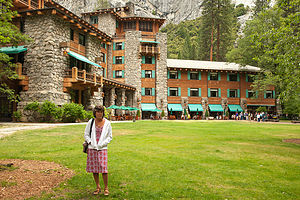 Lolo post lunch at the AhwahneeI love National Park Hotels, and the Ahwahnee is definitely one of its most beautiful. We have eaten here on each of our visits to Yosemite, so this would make 5. We usually like to have lunch here instead of dinner, because it is just as nice, but about half the price. The food is excellent, but quite honestly I wouldn’t care what they served me. I just love sitting in that beautiful dining room with its 34-foot-high floor-to-ceiling windows gazing out at the granite cliffs.
Lolo post lunch at the AhwahneeI love National Park Hotels, and the Ahwahnee is definitely one of its most beautiful. We have eaten here on each of our visits to Yosemite, so this would make 5. We usually like to have lunch here instead of dinner, because it is just as nice, but about half the price. The food is excellent, but quite honestly I wouldn’t care what they served me. I just love sitting in that beautiful dining room with its 34-foot-high floor-to-ceiling windows gazing out at the granite cliffs.
What a nice way to end another wonderful trip to Yosemite.
NOTE: About 8 weeks after we returned home, we received a letter from the Yosemite National Park Service informing us that we were one of the lucky visitors that had been staying in the park during an outbreak of the deadly rodent-borne hantavirus. Fortunately, for us, the cases were only linked to the tent cabins in Curry Village, not Housekeeping Camp. The CDC estimated that as many as 10,000 people could be at risk for the disease.
Description
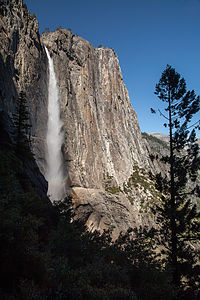 Yosemite FallsYosemite National Park lies near the eastern border of California in the heart of the Sierra Nevada Mountains. Its spectacular waterfalls, soaring granite cliffs, and lush meadows are just a few of the reasons it is considered by many to be nature’s ultimate masterpiece. In the words of John Muir, “it is surely the brightest and the best of all the Lord has built.”
Yosemite FallsYosemite National Park lies near the eastern border of California in the heart of the Sierra Nevada Mountains. Its spectacular waterfalls, soaring granite cliffs, and lush meadows are just a few of the reasons it is considered by many to be nature’s ultimate masterpiece. In the words of John Muir, “it is surely the brightest and the best of all the Lord has built.”
This description will focus on Yosemite Valley, which is the section of the park we visited. Although the Yosemite Valley is just a small portion of Yosemite’s 761,268 acres, it is part receives 95% of its visitors. In fact, an estimated 4.1 million people visit the Valley each year, making it extremely crowded.
Two one-way roads traverse Yosemite Valley: the east-bound Southside Drive and the west-bound Northside Drive, which wind through woodlands and meadows along the base of the 3,000-foot-high granite cliffs. As of today, cars are still allowed to enter and drive through the valley, but visitors are highly encouraged to park their vehicles and use the park’s free shuttle bus, which stops at the major attractions in the valley.
Virtual Tour of Yosemite Valley Highlights
- As you enter the valley, the first sight you’ll see is the 620-foot Bridalveil Falls flowing down from a hanging valley to the valley floor. From the parking area, a short paved path leads to the base of the falls. This is one of the few falls in Yosemite that does not completely dry up in the summer.
- Just past the Bridalveil Fall parking area, the Southside Drive begins to trace the Merced River. Soon El Capitan comes fully into view. This 3,000 foot high granite cliff is the largest single piece of exposed granite in the world and one of the most famous landmarks in Yosemite. If you look closely, you might see small dots that are actually rock climbers along its face.
- Continuing east on the Southside Drive are two riverside picnic areas and beaches: Cathedral Beach and Sentinel Beach.
- Right after the Sentinel Beach parking area is the trailhead for the 4-Mile trail, which ascends more than 3,200 feet from the valley floor to Glacier Point and one of the most spectacular views of the valley.
- A short distance further is Swinging Bridge, another picnic and swimming area. This area is also the westernmost point of the 8-mile bicycle loop that goes through the eastern part of the valley. From this point on, the bike path parallels the road.
- Next stop is the picturesque tiny Yosemite Chapel where many outdoor enthusiasts choose to exchange wedding vows.
- Now you enter the congested and developed portion of the valley.
- Right past the chapel, you can either take a left onto Sentinel Bridge towards Yosemite Village and the park exit, or you can continue straight towards Curry Village, the campgrounds, and Happy Isles Nature Center. For now, let’s stop at Sentinel Bridge for what is probably the most spectacular Half Dome viewpoint in the park. It’s a great spot for a photograph of Half Dome with the Merced River in the foreground.
- Continuing east on the Southside Drive, you pass Housekeeping Camp and Curry Village. Curry Village has lodging, restaurants, bicycle and raft rentals, a grocery store, and other shops. Curry Village is also one of the main parking areas in the valley.
- From Curry Village you can either take Northside Drive across the Ahwahnee Bridge back to Yosemite Village and the park exit, or continue east to the campgrounds. The Happy Isles Nature Center is also this way, but only shuttle buses are allowed on the road to it.
- The Happy Isles Nature Center features exhibits on the natural history of the park. It also serves as the trailhead for some of the best hikes in Yosemite. 1.5 mile trail leads to the top of Vernal Falls and then continues another 1.5 miles to the top of Nevada Falls (two waterfalls that flow even in the summer time). From there you can continue even further into the backcountry of Yosemite, including the cable route up the back of Half Dome.
- From Curry Village, the Northside Drive crosses the Ahwahnee Meadow, a wonderful spot to gaze at Half Dome during sunset, and enters Yosemite Village, the main center of visitor services in the park. Here you’ll find the park’s main Visitor Center, restaurants, lodging, shops, a grocery store, a post office, a medical clinic, the Ansel Adams Gallery, an Indian Cultural Exhibit and more. It’s also a good place to park your car and jump on the shuttle.
- A short dead end road from Yosemite Village leads to the majestic old Ahwahnee Hotel, which has played host to Queen Elizabeth, President John F. Kennedy, and Clint Eastwood, to name a few. This beautiful six-story rock structure offers tremendous views from every room. Within the hotel is the elegant and quite expensive Ahwahnee Dining Room (jackets required for dinner).
- Back on the Northside Drive heading west from Yosemite Village, the next stop is the Yosemite Falls parking area. At 2,425 feet, Yosemite Falls is the highest waterfall in North America. It is actually three waterfalls in one, with an upper, middle and lower section. A short walk from the parking lot along a paved walk leads to the base of Lower Yosemite Falls. This is the most visited landmark in the valley. Except in summer when the fall temporarily dries up, you’ll be sure to be covered in spray.
- A little further west on the Northside Drive is Yosemite Lodge, which marks the end of the developed area of the park going west.
- Right after Yosemite Lodge is Sunnyside Campground/Camp 4, a place where most rock climbers choose to congregate. From this campground begins the popular and strenuous Yosemite Falls hike, which ascends 2,600 feet from the valley floor to the top of the Upper Falls. The views from the top are incredible.
- Continuing west, there is nothing but woods and meadows from which to enjoy the views. Along the road there are several pullouts where you can stop and walk down to the Merced River for a swim. Just after the El Capitan Bridge, you’ll come to the El Capitan Meadow where you’re sure to find people looking through binoculars at the miniscule rock climbers clinging to the granite face.
- Just to the west of El Capitan, Ribbon Falls plunges over 1,600 feet down to the valley floor. It is the seventh highest waterfall in the world. However, it too dries up in the summer time.
- Finally the road nears the end of the Northside Drive at Valley View where El Capitan, on the left, and Cathedral Rocks, on the right, frame a magnificent valley view.
Several guided bus tours are also available. The 2-hour Valley Floor Tour is a great way to get acclimated. Visitors ride through the valley in an open tram while a guide leads a informative discussion of Yosemite’s history and geology. There are many photo stops along the way. In addition, there are bus tours out of the valley to Glacier Point, the Mariposa Grove of sequoia trees, and Tuolumne Meadows.
Although much of Yosemite can be enjoyed from the comforts of your car or a shuttle, the best way to truly experience Yosemite is do get out and experience it more directly.
Things to do in Yosemite
- Hike one of the many trails around the valley, ranging from an easy walk to the base of Lower Yosemite Falls to the strenuous 16-mile round trip hike up the back of Half Dome via cables
- Take an overnight backpacking trip
- Bike along the 12 miles of bicycle paths that loop through the Valley. Rentals are available at Curry Village and Yosemite Lodge.
- Rock climb in one of the premier climbing places in the world
- Raft down the calm waters of the Merced River through the valley. Rentals are available at Curry Village.
- Swim or tube in the Merced River. Besides the designated beaches, there are many pullouts along the road from which you can walk down to the river.
- Join one of the many ranger walks, which are offered daily
- Take a free art class at the Yosemite Art and Education Center
- Photograph the amazing scenery of the valley and surrounding granite cliffs
- Browse the Ansel Adams Gallery and see some of the photographs that first made Yosemite famous
- Relax in the meadow while gazing up at Half Dome or El Capitan
- Dine at the 5-star Ahwahnee Hotel, where presidents and royalty have stayed
Although many try to see Yosemite in a day, it is best to devote several days to seeing all the park has to offer. Besides the numerous hotels, lodges, and cabins in the Valley, there are three RV campgrounds: Upper Pines (238 sites), Lower Pines (60 sites), and North Pines (81 sites). That’s less than 400 campsites to accommodate all the people that want to camp here.
Since these campgrounds usually fill-up within the first hour they become available, it is essential to make your reservations as soon as possible. Campground reservations are available in blocks of one month at a time, up to five months in advance, on the 15th of each month at 7 am Pacific time. For example, if your arrival date is July 15 through August 14, the first day you can make reservations is March 15. The National Park Reservation System can be found at www.recreation.gov. Good luck!
